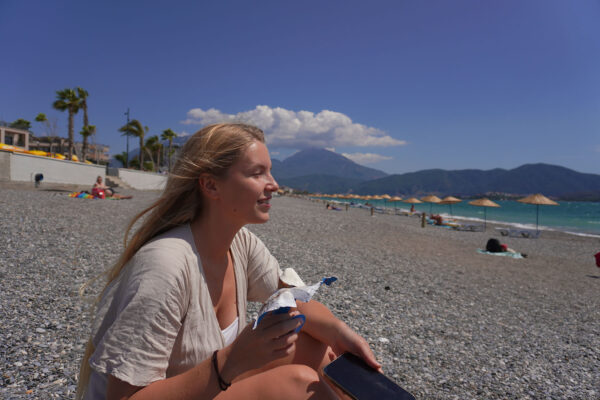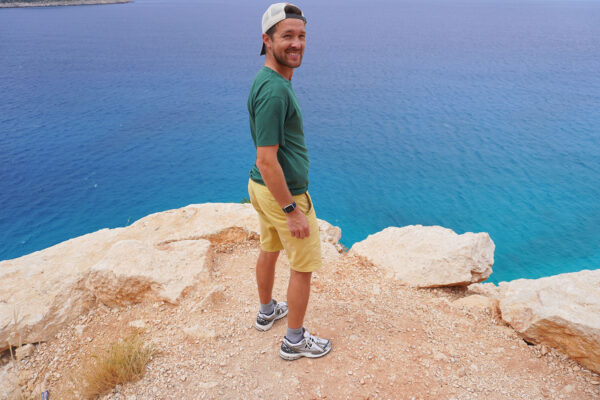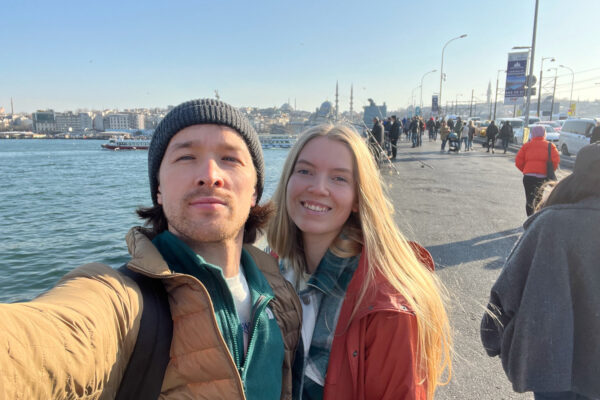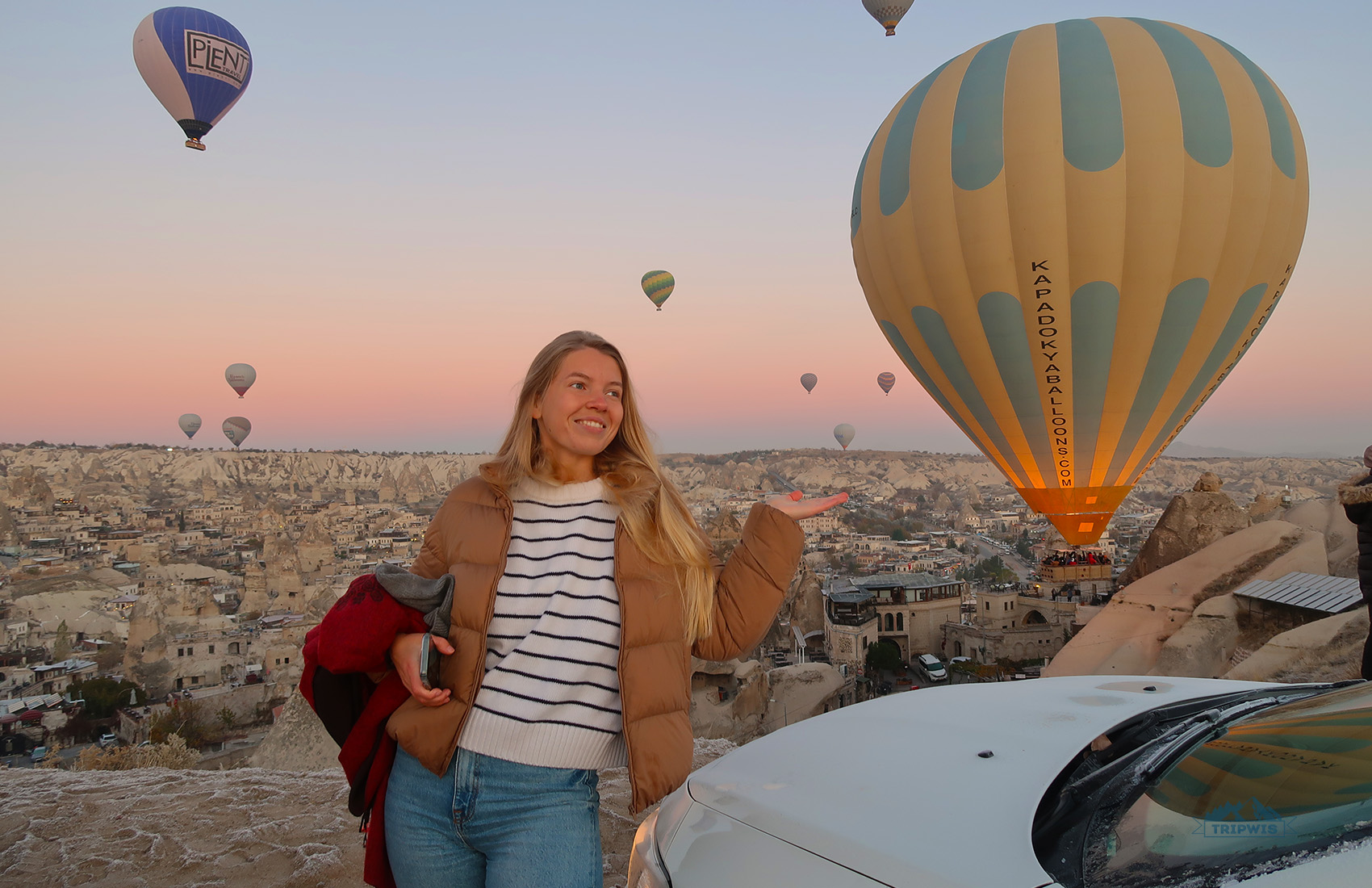
Even if you’re the most rugged individualist when it comes to travel, chances are you still won’t be able to resist taking the coveted photo in Cappadocia — you, standing in front of the dozens of giant hot air balloons filling the air.
The visual is so prominent in everybody’s minds that it became the only Cappadocian identity marker that is known worldwide. But did you know that the region has so much more to offer? Valleys with rock surfaces that look like they belong on another planet, ancient churches carved in deep caves, castles created from volcanic stone mounts — Cappadocia is a treasure trove of experiences, and most of them do not need the hot air balloon treatment to be exciting.
During our first Cappadocia trip, we came to Göreme after midnight and still made the trek to the nearest viewpoint — even without the hot air balloons, the awe from the moonlit scene hit me with full force! If you too want to discover other things to do in Cappadocia, Turkey — keep reading, you’re in for a wild ride.
Article contents
- How to get to Cappadocia?
- Where to stay in Cappadocia?
- My list of 14 things to do in Cappadocia — from hot air balloon ride to other unique Cappadocian landmarks
- Our Cappadocia itinerary as an example
- Most popular tours in Cappadocia
- Where to eat in Cappadocia?
- Things to know before coming to Cappadocia
How to get to Cappadocia?
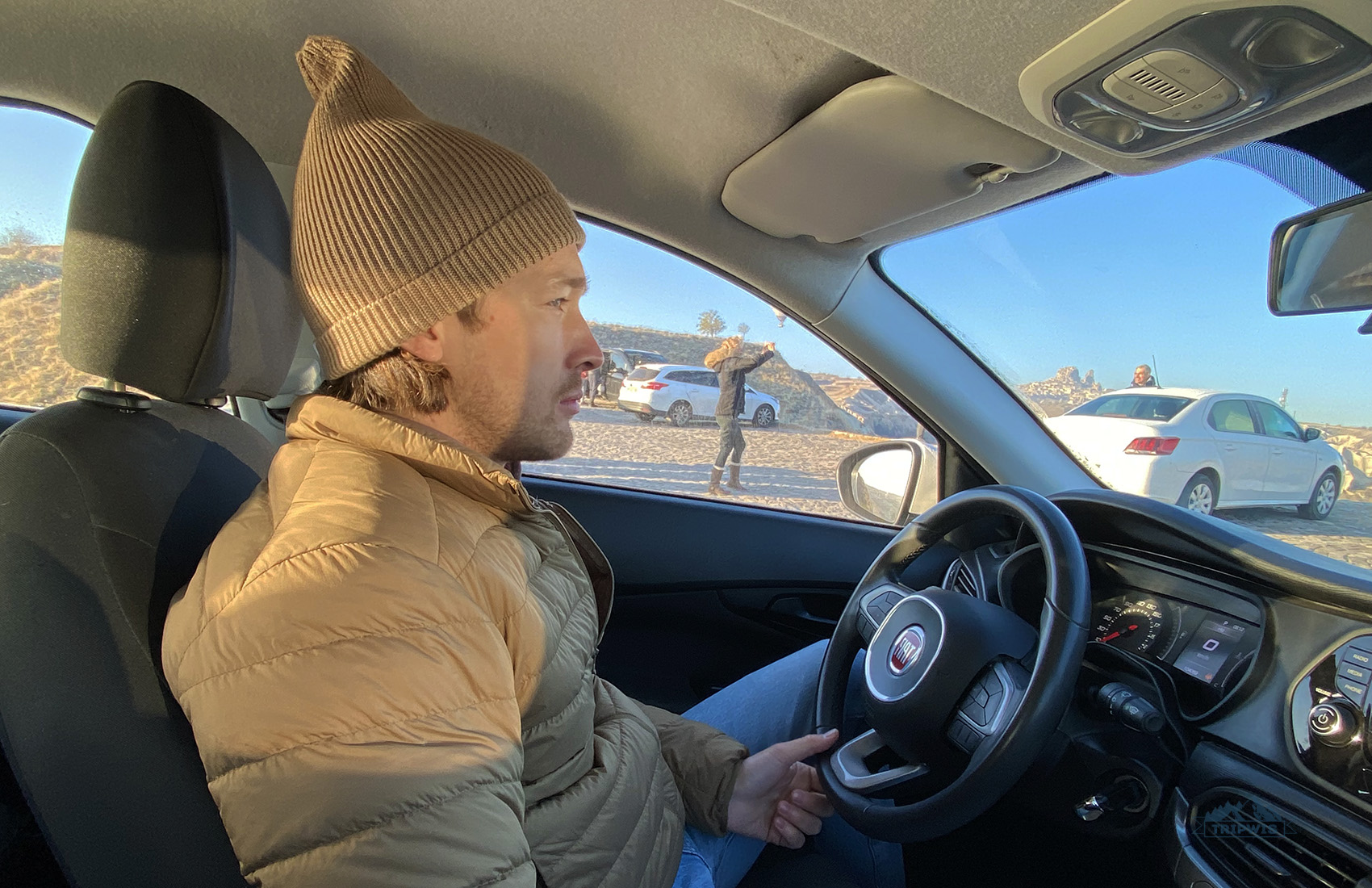
Before our first trip to Cappadocia, we thought that you have to venture far out into Turkey’s outback in order to witness the otherworldly scenery of the region. However, it turns out that Cappadocia isn’t set in the middle of nowhere like its landscapes led us to believe.
Cappadocia is:
- Far from Istanbul — 750 km
- Relatively close to Antalya (at least close enough to rent a car and go on a fun road trip to Cappadocia from Antalya) — 500 km
- Not too far from Turkey’s capital, Ankara — 300 km
- Very close to Kayseri International Airport — 70 km
Side note: Cappadocia is a region that spans multiple provinces and tiny towns. The main town of the area is Göreme — Cappadocia’s tourist center. Every landmark’s distance in the list below will be in relation to Göreme, so remember the name for future reference!
There are a few ways you can use to get to Cappadocia:
By plane to one of Cappadocia’s airports + transfer to a hotel
Cappadocia is served by two airports: Kayseri (ASR) and Nevşehir (NAV). The former one is the major airport of the region, while the latter is located closer to Göreme and all the main tourist attractions.
If you’re flying from Istanbul, expect to spend around $50 per plane ticket. The flight lasts an hour and a half — just enough time to watch Airplane! for the hundredth time. Surely, I am serious.
Though there are buses and taxis that can get you from the airport to Göreme, I would encourage you to book a transfer beforehand because it’s more convenient. A transfer from either Kayseri or Nevşehir Airport to your hotel will take approximately one hour and will cost on average $12 per passenger.
By a rented car from either Istanbul or Antalya
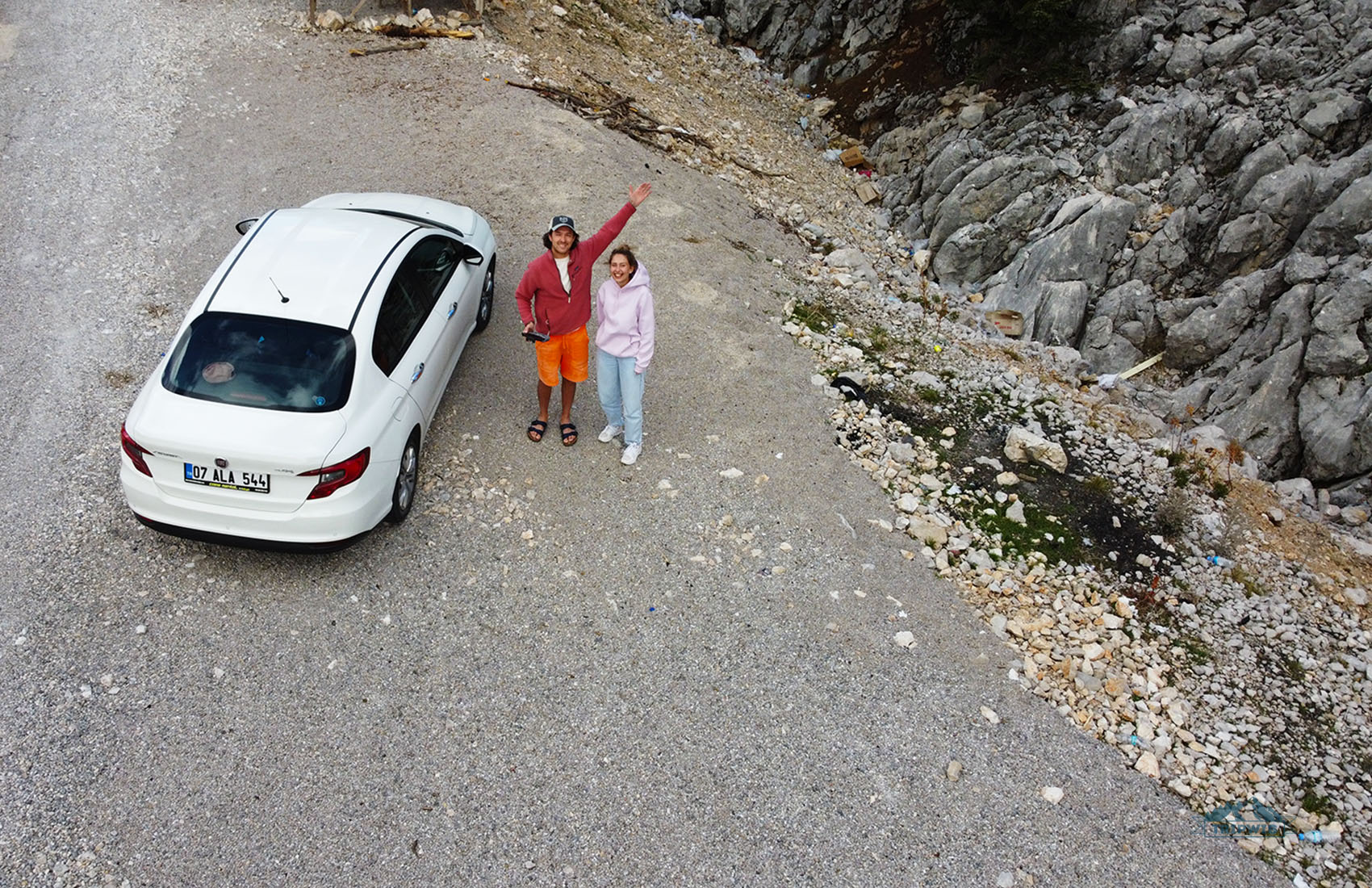
That’s what we did. A road trip to Cappadocia is a nice option for the travelers who value freedom of movement. Renting a car in Turkey is an easy process when you know what to expect — that’s why I stick to Localrent service when considering getting a vehicle for our foreign escapades (I’ve used it myriad times).
The plan for our last trip to Turkey was to rent a car in Antalya and drive it to Cappadocia. Seven hours on the road passed pleasantly and quickly! Apart from getting to the region, you will absolutely need a car in Cappadocia if you want to get a full experience. Plus, driving in Cappadocia is an okay ordeal — apart from parking issues, we didn’t regret renting a car here in the slightest.
Though I have an in-depth breakdown of the car hire process in Turkey, there are a few Cappadocia-centric tips:
- You could fly into Cappadocia and rent a car at Kayseri, Nevşehir, or Uçhisar, but it’s cheaper to do it in Antalya
- Gas in Cappadocia is not cheap: It’s 50 lira per liter / $1,25
- The driving manner of locals is something to get used to: They are pretty aggressive, can cut you off, and never ever use turn signals. Be vigilant on the road, especially in areas with heavy traffic
With an organized tour from Antalya or Istanbul
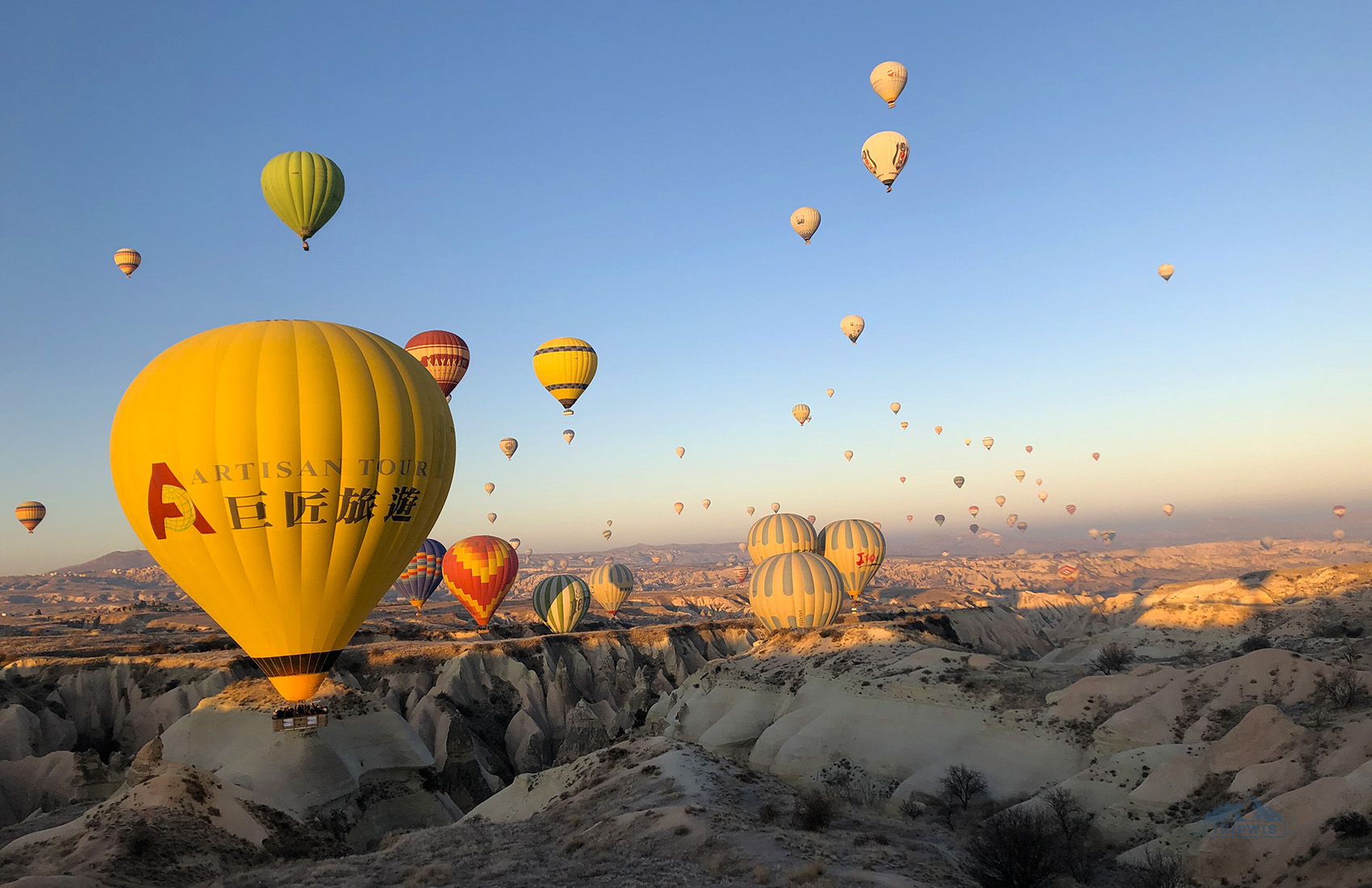
An organized tour to Cappadocia is one of the most popular tours in Turkey. Everything is taken care of — from transportation, food, and accommodation (usually a cave hotel, which is exciting!) to a fully stacked itinerary and guide services. However, the experience isn’t without its pitfalls: The journey to Cappadocia usually lasts 8 hours on average, and the entire tour spans across 2 whole days.
A bus tour to Cappadocia is highly advertised in Antalya and its resort towns because it’s a relatively easier journey. For travelers from Istanbul the tour includes flights.
So, depending on where you start your journey to Cappadocia from, expect to pay:
- From $70 for an organized tour from Antalya
- $750 for an organized tour from Istanbul
Side note: Before you go ahead and book a ridiculously good deal, know that a hot air balloon ride is usually not included in the tour package, so expect to pay extra $150–$200.
By bus from Istanbul or Antalya
If you don’t have a driver’s license to rent a car in Turkey and aren’t that fond of flying, you can get a bus ticket to Cappadocia:
- The journey from Istanbul will take 12 hours on average and cost anywhere between $20 and $30
- The drive from Antalya will take approximately 9 hours and cost $15 to $20
You’ll find the exact prices and bus schedule on obilet.com.
Where to stay in Cappadocia?
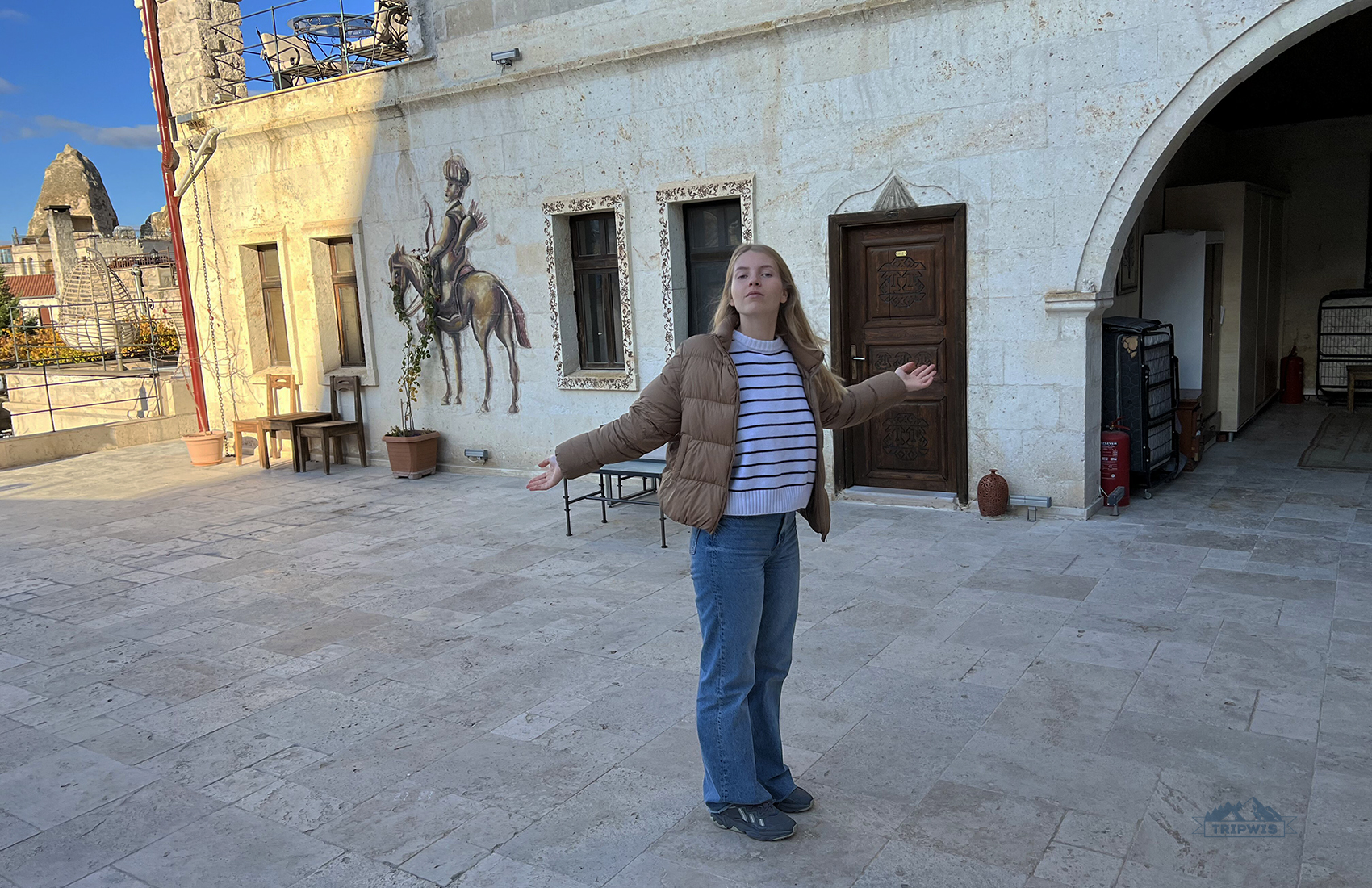
As we’ve mentioned before, Cappadocia is comprised of many small towns and villages — a fact that makes planning a trip here a bit confusing for first-time travelers. Which town to choose for your stay in Cappadocia?
- Göreme is the touristic heart of the region, and most of the top landmarks of Cappadocia are concentrated within Göreme’s surroundings.
Some people scoff at the idea of staying in Göreme: They say it’s too commercial and that the area lacks authenticity and local feel. I do not particularly agree with the sentiment — yes, Göreme can feel touristy at times, but what can you expect from a place where tourism is the main business sector? In any case, if you have limited time in Cappadocia (and most likely, you do — people rarely spend more than three days here), then staying in the middle of all the action seems like an obvious choice.
Anyway, if you despise anything that can be described as conventionally tourist-forward, then staying in one of Cappadocia’s other locations is a possibility: Uçhisar, Ürgüp, and Ortahisar. My guide to where to stay in Cappadocia has all the details you’re looking for concerning these destinations!
One could argue that smaller villages outside Göreme area will provide cheaper accommodation options… Well, let’s see.
Here’s a room price breakdown for hotels in Cappadocia in September of 2025 (check Booking.com for up-to-date rates):
- Göreme — from $100 a night
- Uçhisar — from $80
- Ürgüp — from $100
- Ortahisar — from $70
If you still want to make your trip a tad more budget-friendly, you should consider coming to Cappadocia during low tourist season — from November to April. Prices for accommodation drop significantly during this time: A hotel in Göreme, for example, will go from September’s $100 per night to $60.
We’ve been to Cappadocia at the end of November and can definitely say it’s a year-round destination. Yes, it gets colder in winter, and you need to choose a hotel more carefully (especially if you’re staying in a cave hotel), and hot air balloons are more likely to be delayed. But overall, the experience is still great, partly because there are fewer people.
Why stay in a cave hotel?
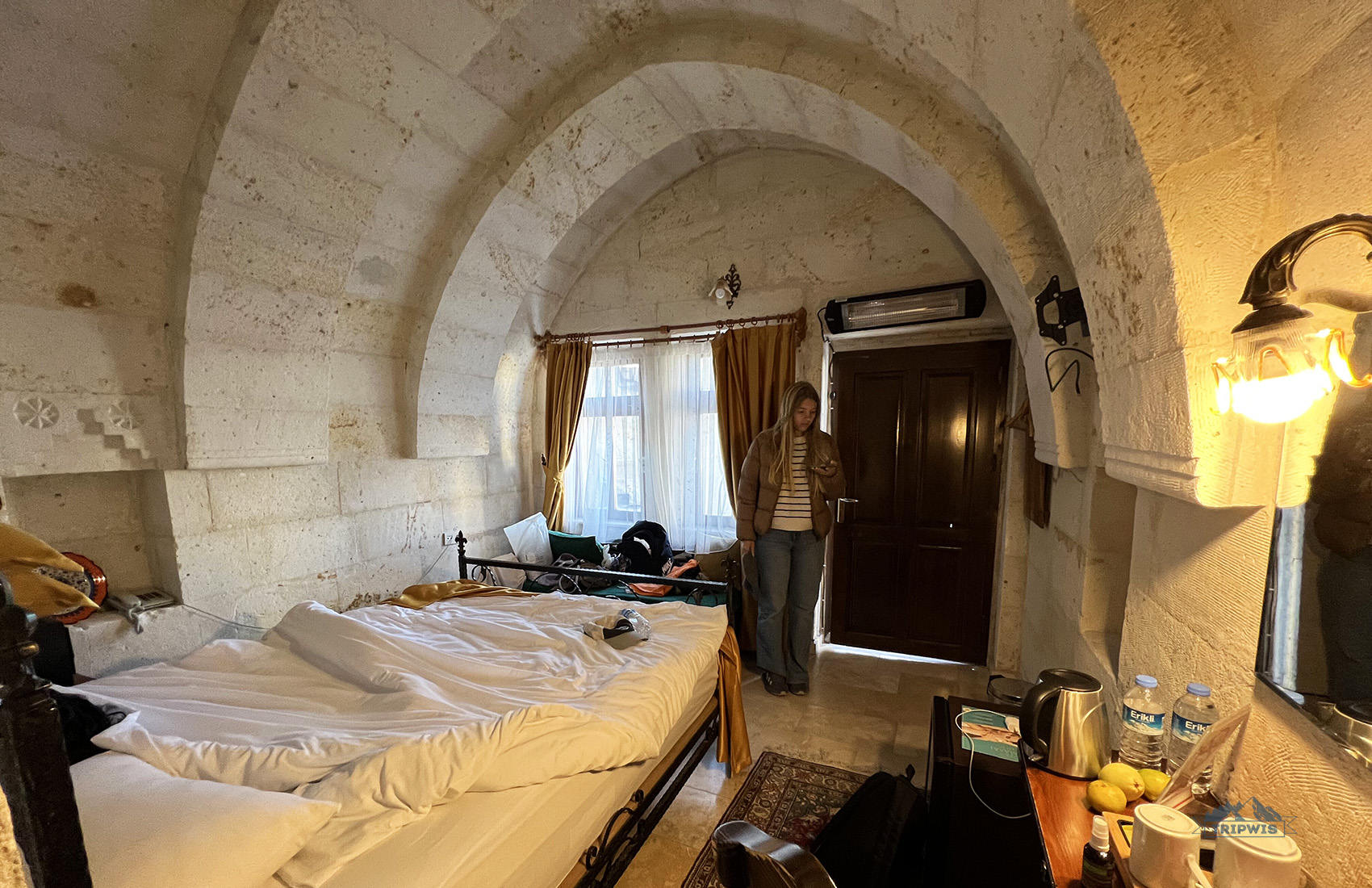
Learning about cave hotels is your paramount duty — Cappadocia is one of the few places in the world where you can actually stay inside a cave!
A short explanation: Cappadocian moonscape-ish terrain was originally formed by multiple volcano eruptions. With time, soft and pliable tuff stone, layers of ash and basalt, and erosion created the scenery you see today — towering rock formations and the sculpted hills of different colors. Centuries ago, monastic hermits (and then Christians seeking refuge from persecution) came here and decided that the stone pillars were great to build homes in. Not build, per se, more so carve — thus cave dwellings and then churches were born inside Cappadocian valleys.
Of course, the modern cave rooms have all the necessary amenities for a comfortable stay: You won’t be sleeping on a hard stone floor — a king-size bed with crisp sheets and beautiful bed linens awaits your embrace! The historic atmosphere still remains though: The lack of light creates an ambiance conclusive with quiet retrospection of yesteryears and human struggles (you can always turn on Netflix to avoid the troubling thoughts).
Warning: You should not stay in a cave hotel if you’re afraid of confined spaces, can’t stand the lack of sunlight for prolonged periods of time, or get easily spooked by small pieces of tuff stone breaking off onto your bed at random times in the night. Thankfully, there are other, “normal” hotels in Cappadocia (which are, coincidentally, cheaper); you can find some examples in my guide here.
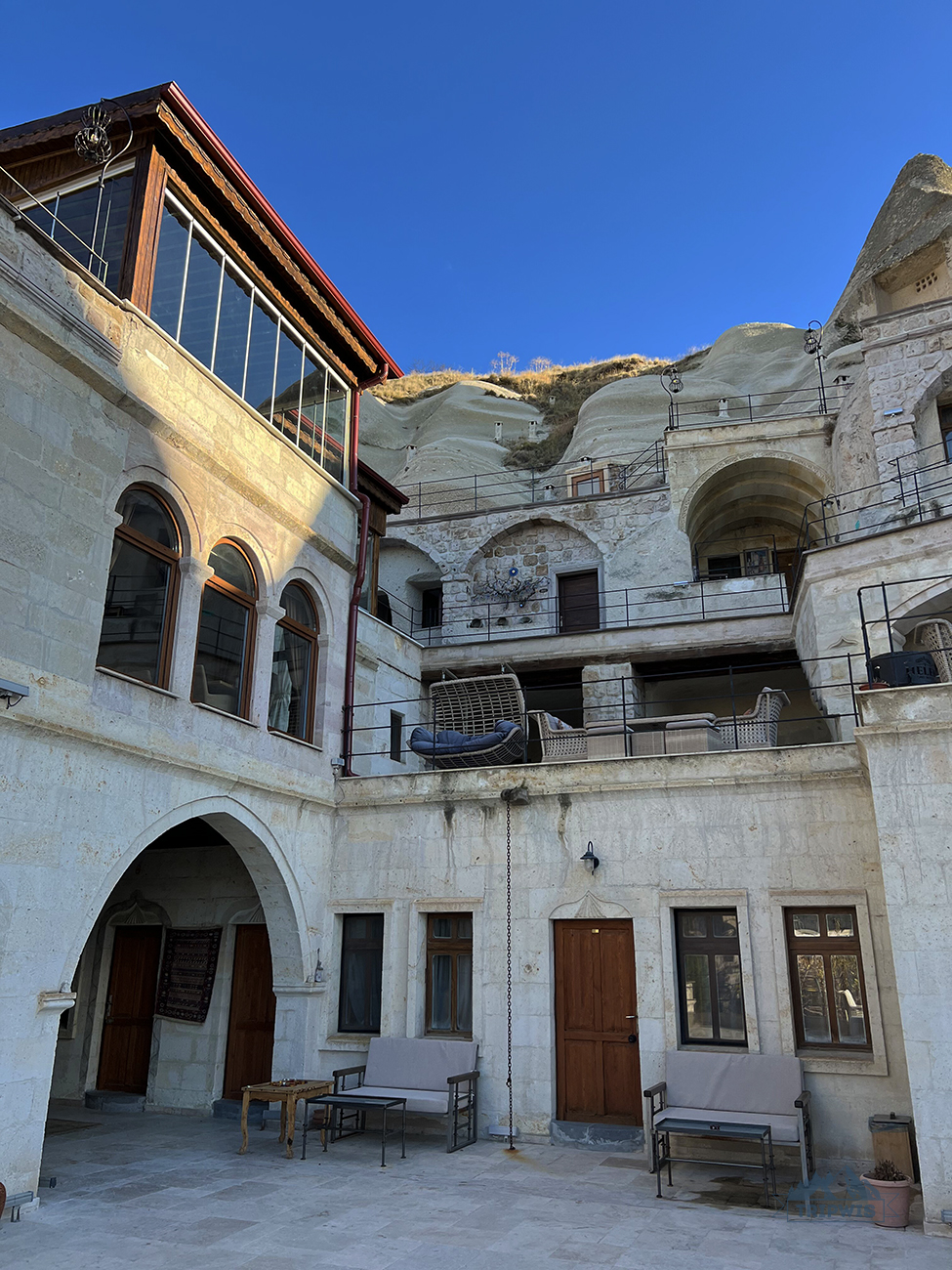 |
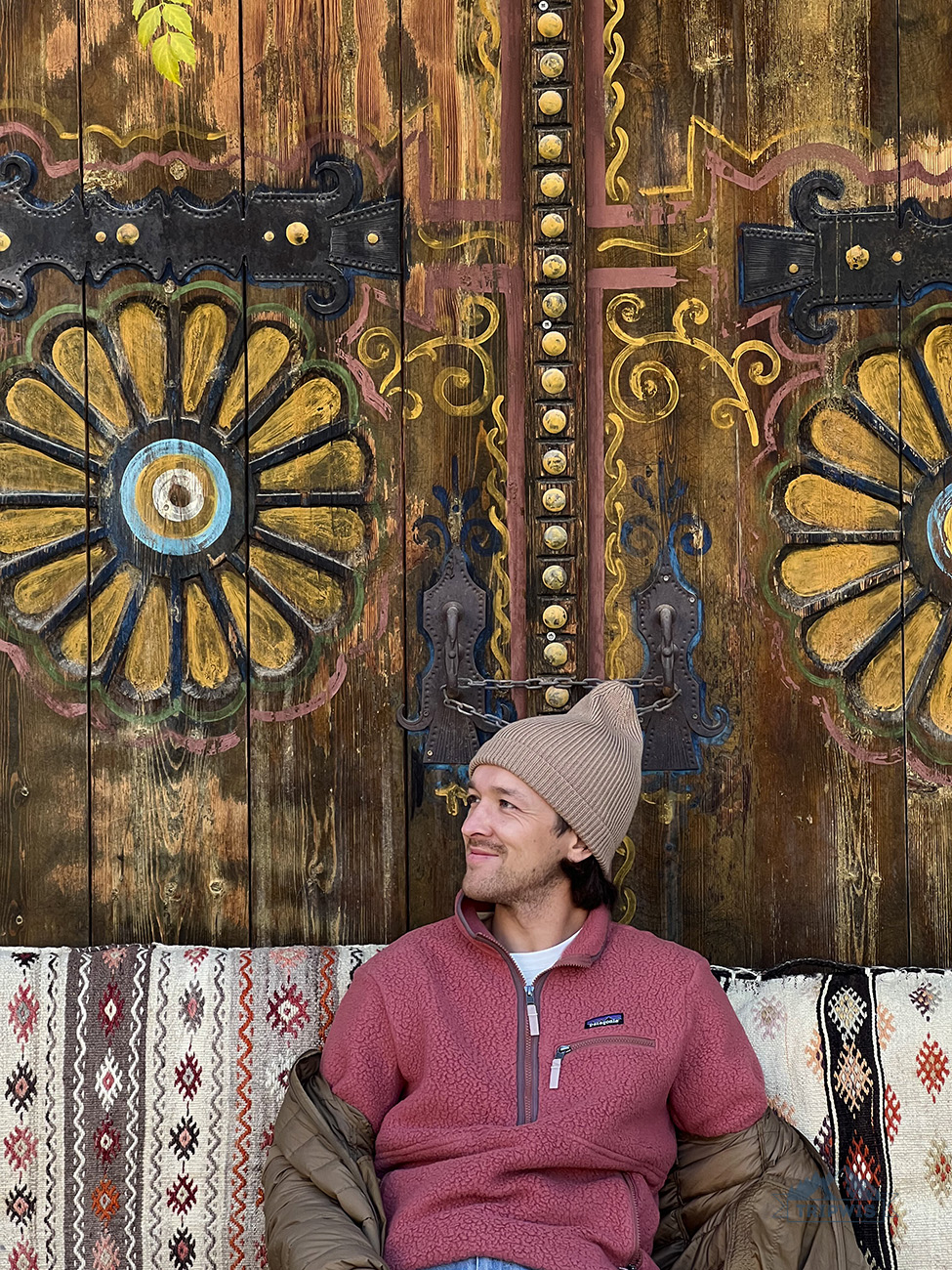 |
But let’s focus on more “fun” options; these are the best cave hotels in Cappadocia, in my opinion:
- We stayed at: Onur Cave Cappadocia (Göreme; off-season rate $130, peak season rate $165) — an absolute gem of a hotel for winter days in Göreme. It’s warm (an important thing to look for in the low season), with cozy interiors, opulent breakfasts, and its own rooftop viewpoint for watching hot air balloons!
- Seki Cave Suites (Çavuşin; off-season rate $140, peak season rate $200) — located in a quiet Çavuşin, it’s just a 10-minute drive from Göreme town. With a stunning rooftop terrace and well-appointed rooms, this hotel should be at the top of your list of places to consider for staying in Cappadocia. Though a true cave hotel, the rooms here do not feel claustrophobic; and if you have cash to burn, pick a deluxe or king suite for your stay — it has a private balcony for spectacular views and a hot tub.
- Milat Cave Hotel (Göreme; off-season rate $70, peak season rate $120) — set right in the middle of all the action, it guarantees easy access to all of Göreme’s iconic locations. The rooms are on the smaller side, but let’s face it: You’re not going to spend much time inside anyways. Great terrace views and a delectable breakfast spread make up for the rather cramped living quarters in heaps.
- Carus Cappadocia (Göreme; off-season rate $200, peak season rate $280) — now that’s what being surrounded by luxury feels like in Cappadocia! Indoor pool, rock-cut underground spa facilities, chic lounge bar, rooftop restaurant — even without mentioning the suites, the description paints a picture one wants to experience as soon as possible. But let’s shed some light on the rooms: Choosing between the authentic dimly lit and cozy cave dwellings and modern, with a lot more natural light stone rooms will be the hardest decision of your trip.
My list of 14 things to do in Cappadocia
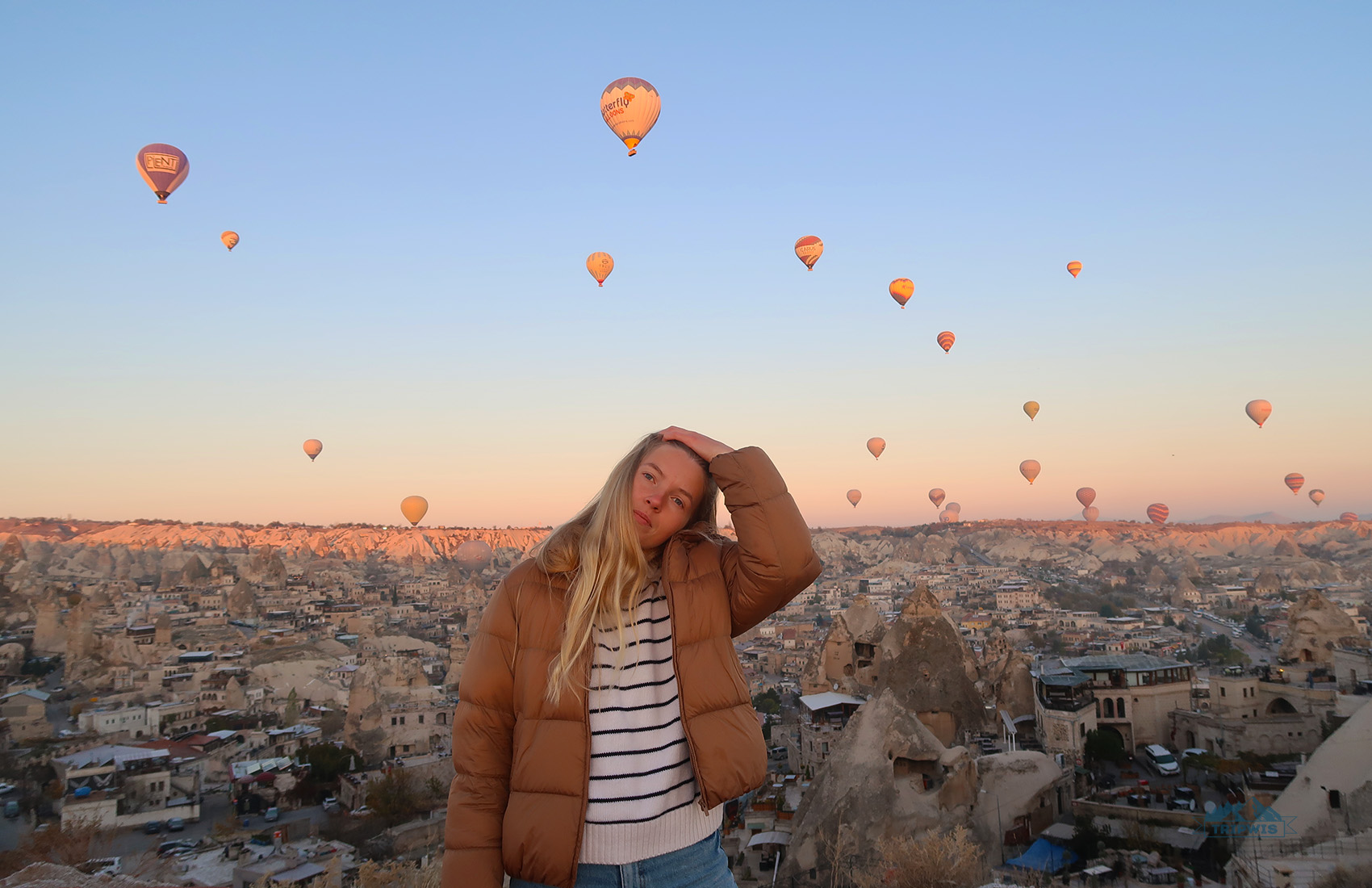
I know many cases when tourists visiting Cappadocia hightailed it out of the region as soon as their hot air balloon touched ground. I cannot even begin to describe how wrong it is: Sure, the experience of flying in a hot air balloon is a once-in-a-lifetime memory for all of us, but the area has so much more to offer to its guests. From deep canyons, sprawling valleys, tiny rock-cut cave churches to chasing sunsets and riding horses, — you don’t have to spend a week here to get the full picture of this extraordinary location. A few days is enough, and I’m proud to present you with my list of things to do in Cappadocia in 3 days. But first, the belle of the ball — let’s start with the hot air balloon ride.
Experience the iconic hot air balloon ride
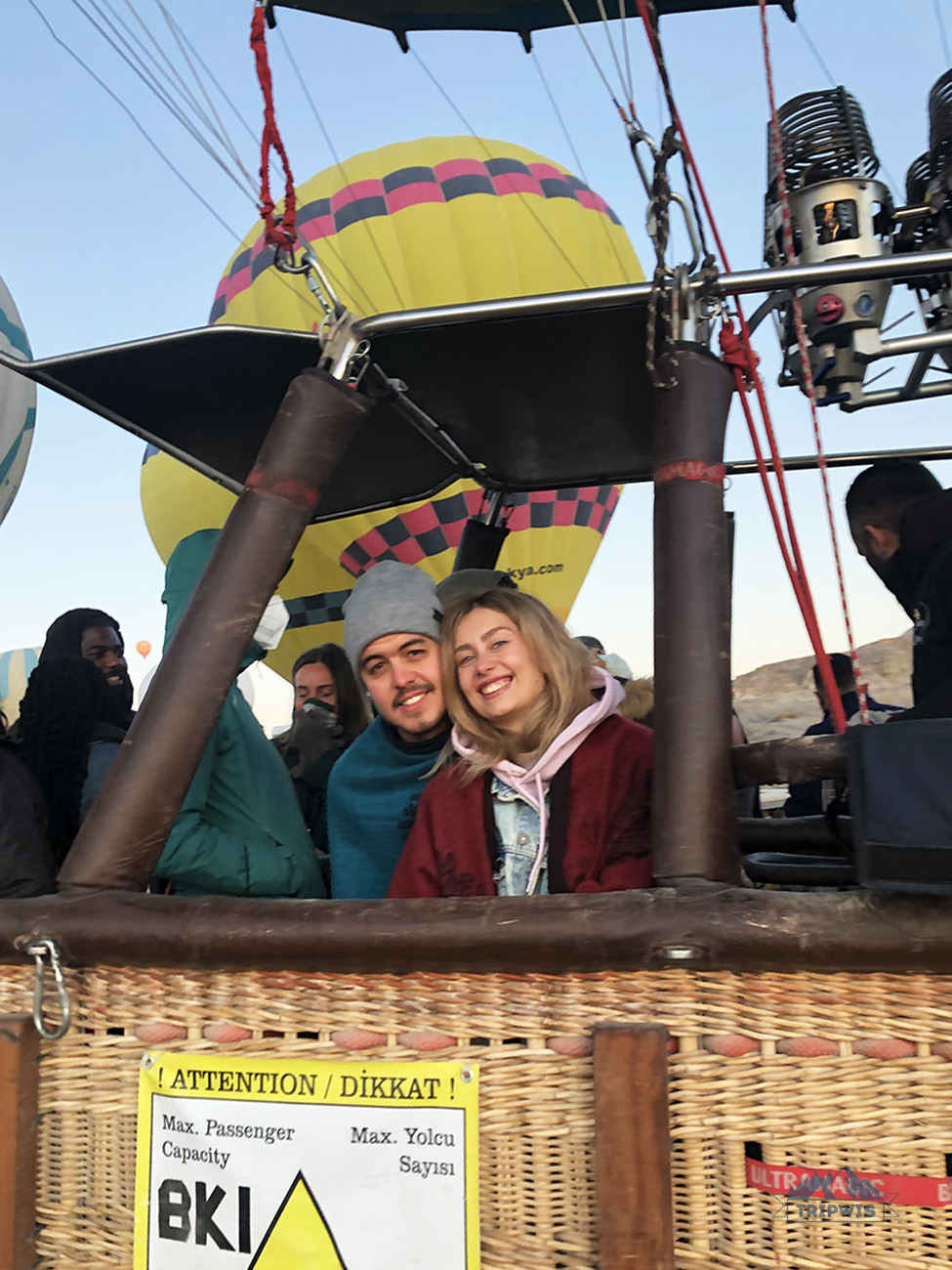 |
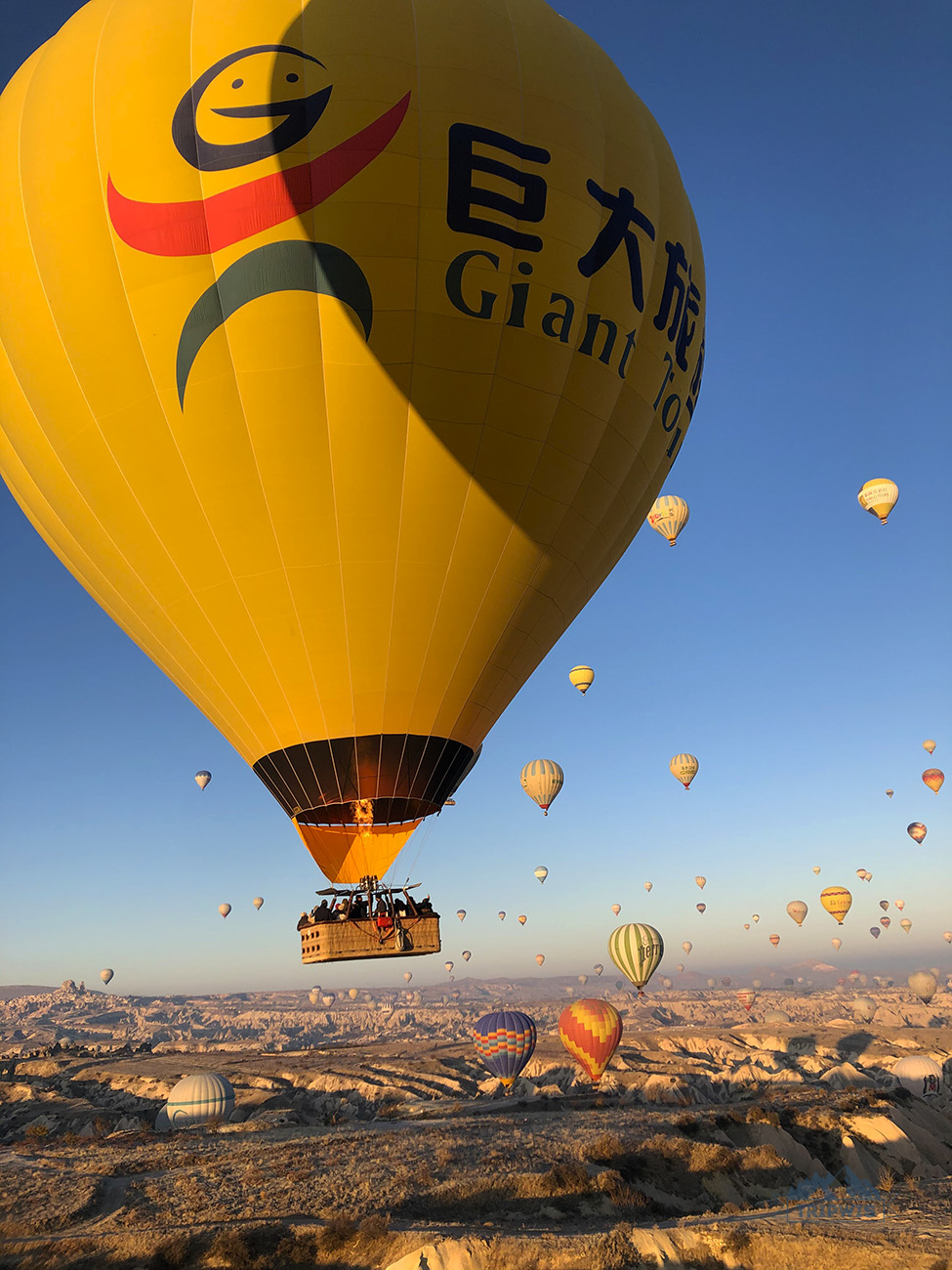 |
Ever since I was little and first saw the The Adventures of Baron Munchausen (or read Jules Verne’s Five Weeks in a Balloon), I have associated hot air balloon rides with magical quests — crusades over foreign distant lands that came with great feats of courage and lifelong memories. Now, as adults, the moment I set my sights on a ride in a hot air balloon in Cappadocia, all the old feelings came rushing back.
Cappadocia’s main appeal is the opportunity to watch its otherworldly scenery from the wicker basket of a balloon slowly gliding through the air. The entire ordeal and a rush of emotions you’ll get from it is hard to put into words — it’s a little scary at first, then, as the sun peeks out over the horizon and the entire valley fills with soft orange light, it becomes truly wonderful.
Since it’s the primary activity of the region, there are countless of companies that provide the hot air balloon experience in Cappadocia. Personally, I believe that you can never go wrong with the most well-reviewed offers (it’s hard to fake 2k+ personal testimonies) — and Discovery Balloons seems to be the most trusted organized tour company of all.
You can book their Sunrise Hot Air Balloon Flight via:
Based on common sense, one would guess that a hot air balloon flight in Cappadocia is not a cheap activity — and they’ll be right! In peak tourist season, the price can go up to $350 per person. In off-season though (November*, December and onwards), you can experience the magic for as low as $120 per person. In general, the amount you’ll pay for the activity depends on the tour provider’s credibility and popularity, potential add-ons like breakfast and champagne, and other factors.
*Though generally considered to be low season in Cappadocia, November pleasantly surprised me with great deals and lack of crowds. It wasn’t even that cold! However, you must keep in mind the season’s unpredictable weather — due to winds and rain, the rides can be delayed or cancelled, hence the lowered prices. It’s a true gamble!
See that third option on the widget above? That’s the cheapest balloon ride that’s recently appeared in Cappadocia — just $100 during high season! The thing is that the flight takes place far from the regular spots, above the Soganli valley. Fewer people in the basket, a bit shorter flight time — hence the lower price tag. I’d give it a shot!
Side note: Even if you pick a more expensive offer, know that you won’t be in the basket alone; there will be 20–25 people on average sharing in the experience with you. However, the basket usually doesn’t feel “that” crowded. Try and snag a spot closer to the railing for uninterrupted views!
Terrified of heights? You don’t have to actually ride in a hot air balloon in Cappadocia to get closer to the region’s magnificent allure. Waking up before dawn and walking to one of the many viewpoints in the area is preparation enough for the sensational sight. As the sun comes up, the valley fills with dozens of hot air balloons, all yours to marvel at. That’s why many travelers that have already flown in a hot air balloon dedicate their second early morning to simply admiring the panorama from afar.
Explore the streets of Göreme
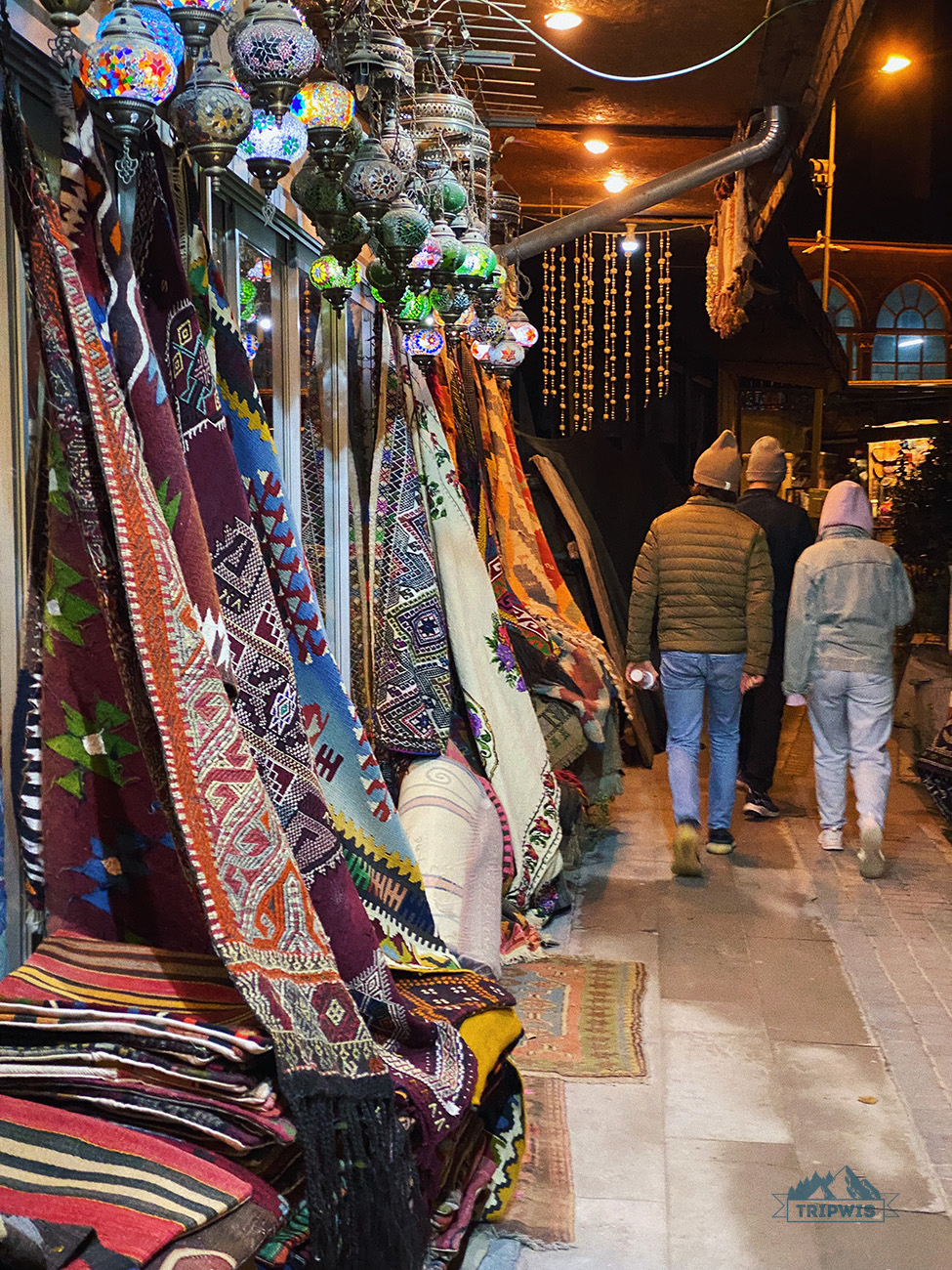 |
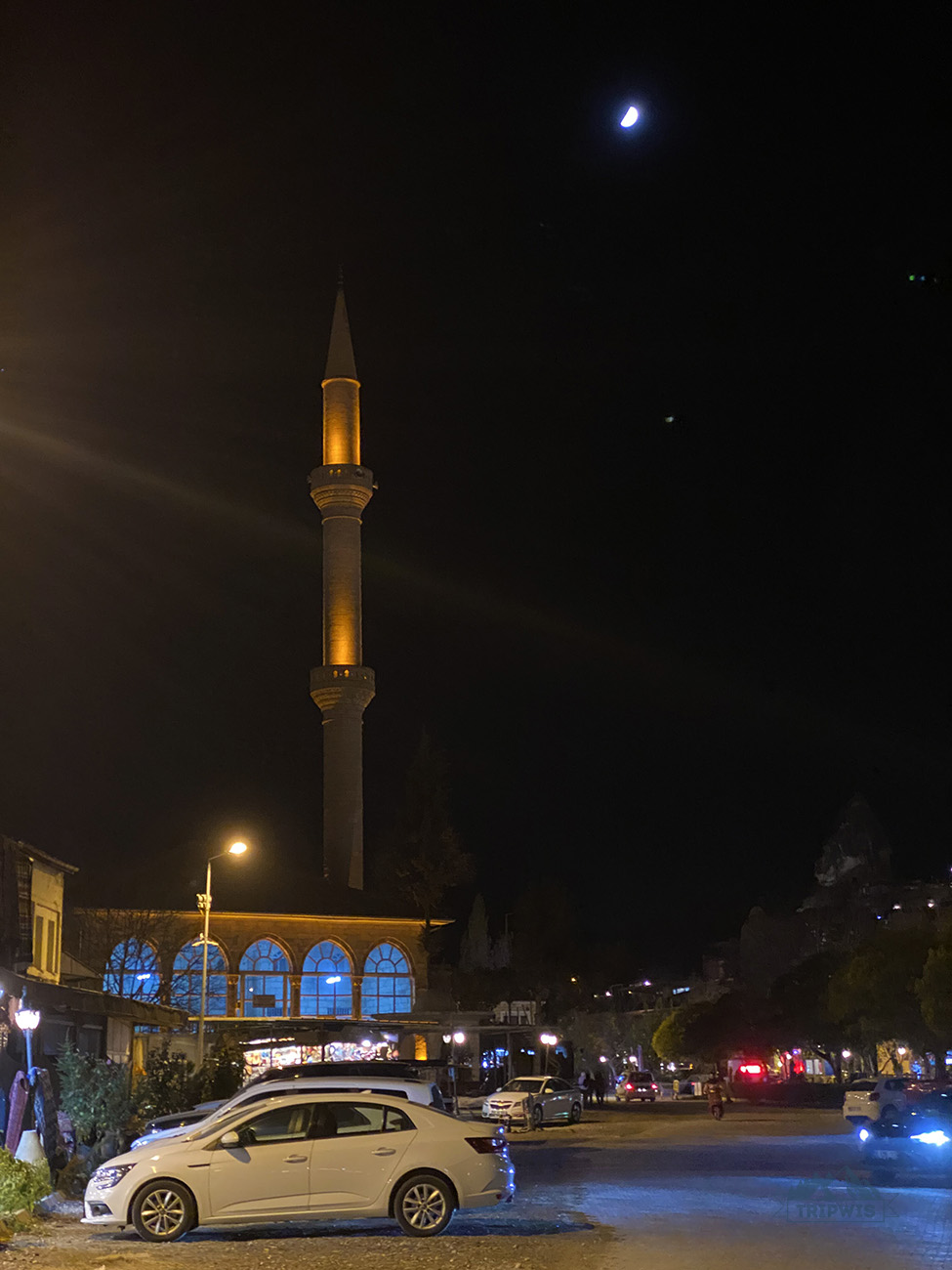 |
There are plenty of similarly exciting things to do in Cappadocia other than taking a hot air balloon ride! For example, simply exploring the town of Göreme where the unique landscape means spectacular views even inside city limits.
Göreme’s layout morphs into surrounding terrain: Walking around the narrow cobblestone streets, one can still see the link between Göreme and both its natural environment and history of the humans that inhabited the area in the olden days. Weird rock formations and many caves that are carved into the hillsides are abound even in the town’s center.
Apart from the fairy-chimney-dotted skyline, there is plenty to see in Göreme town:
- Small cafes adorned with traditional Turkish motifs,
- artisan workshops that sell handmade souvenirs,
- carpet shops that have the potential to hypnotize you with a myriad of designs and colors on offer
Despite being described as “too touristy” at times, I found Göreme to be absolutely charming!
Side note: Wear comfortable shoes when exploring the town and get ready for a glute workout, since Göreme is very hilly. The beauty of the town is worth the effort though!
Once the sun starts to dip behind the horizon, there are still plenty of things to do and see in Göreme. The golden hour is over, and now the scenery gets a makeover of artificial illumination: The hillsides turn soft yellow, pink, and even blue — all the sharp angles are rounded by the unique shadows, and the colorful tints definitely bring a fun touch to an otherwise bland beige-colored landscape.
Scale the stairs of Uçhisar Castle
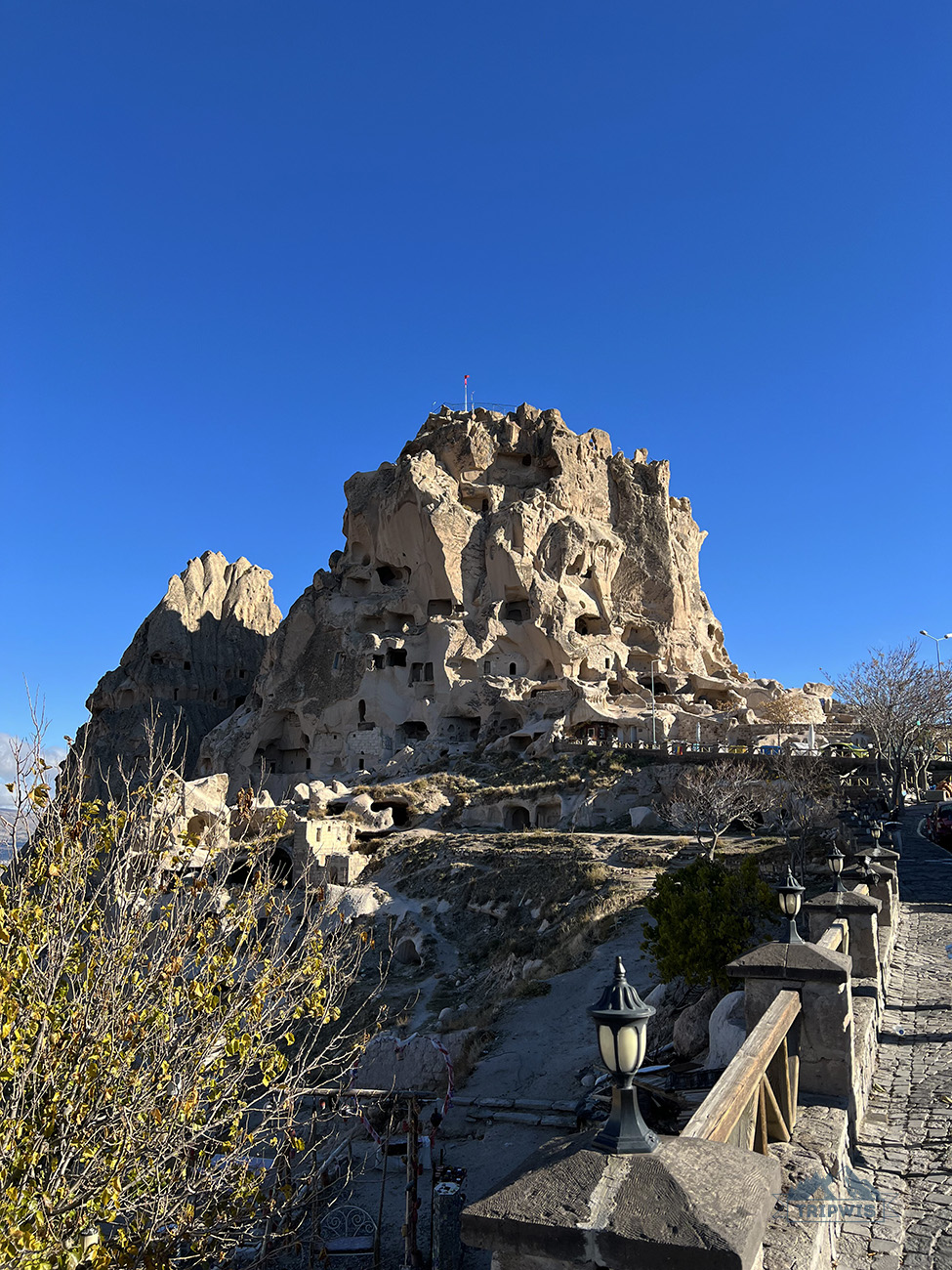 |
 |
Located 4 kilometers away from Göreme, the town of Uçhisar is the second-most enchanting and atmospheric destination in Cappadocia. Here, the familiar moonscape-ness of the terrain gets a stunning break from being monotonous: The highest Cappadocia point — the famous Uçhisar Castle — pierces the sky with its elaborate and unique shape.
They say that you cannot confuse Uçhisar for any other local town because of this structure alone. Most compare it to a free-style 3D puzzle of caves and stairs carved into the once pliable tuff rock, but upon visiting and seeing the castle myself I would match up the site to a giant ant hill. Winding tunnels and long staircases create a maze-like feel that you get once you decide to explore the castle from the inside. The views that open up from the Uçhisar Castle are worth the struggle of the stairs — you can see the entire Cappadocia region from the top.
The impressive architecture of the castle brings tons of visitors to the site, particularly during golden hour. So, if you want to snag prime sunset viewing location, come a bit early.
Personally, I think that viewing the Uçhisar Castle from afar is just as great as entering its labyrinth-like structure — and it’s free! You can get amazing Cappadocia views from other sites, and the beauty of Uçhisar is in the castle-hill itself.
Opening hours: 7 a.m. – 9 p.m.; the outside territory is open 24/7
Entry ticket: 320 lira / $8
Parking: 60 lira / $1,5
Awe at the birds’ flight at Pigeon Valley
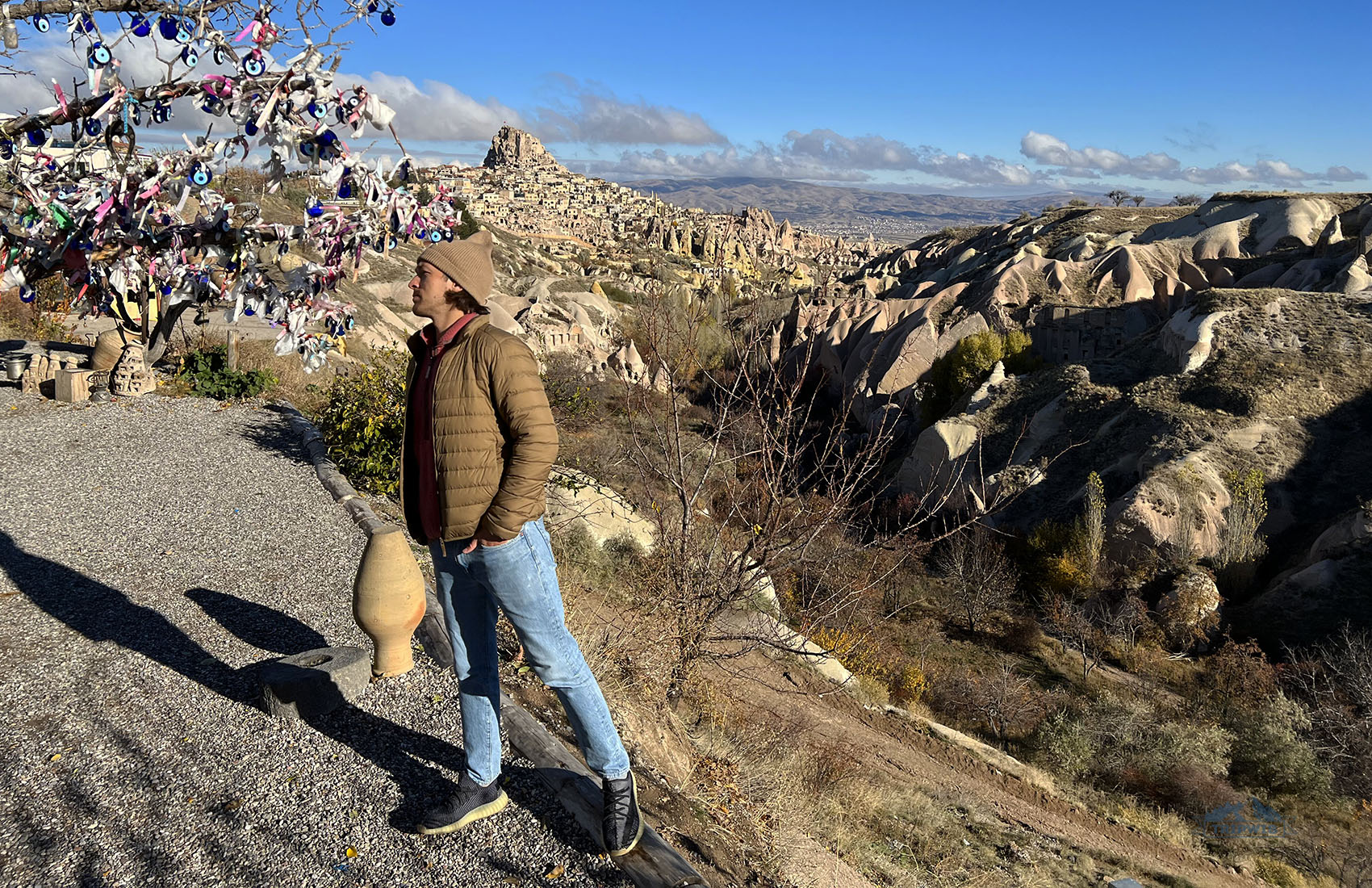
Admiring the many stunning valleys should be at the top of your list of things to do in Cappadocia in Turkey. Those who are more adventurous but crowd-weary will spend the long hours exploring the valleys on foot, while just curious tourists will appreciate watching the lay of the land from above. And oh boy, there is so much to see here!
Pigeon Valley is our personal favorite valley of the region, since the local viewpoint has plenty of picture-worthy angles.
Let’s start off with the name: As you might’ve guessed, the valley is home to countless of pigeons. The birds have a tight connection to Cappadocia’s valleys — for centuries, they were cared for by locals. Why? The pigeon’s poop was used as a rich fertilizer to grow produce in this otherwise arid landscape, and their eggs (shells that got dried out and mushed into powder) helped create gorgeous drawings in cave churches.
- Now, imagine this: You stand before the sprawling Pigeon Valley, at the viewpoint that has a full perspective on the Uçhisar Castle. A faint clinking melody from the Evil Eye Tree (a tree that is encased in thousands of ribbons and nazars — eye-shaped blue amulets) fills the air. Then suddenly a flock of birds takes flight and soars to the sky right in front of you. If it isn’t a picture-perfect moment, I don’t know what is!
Pigeon Valley viewpoint has many little souvenir stalls to inspect. Though pretty kitschy, they are an integral part of your Cappadocia experience. Personally, I wasted no time getting cute trinkets to bring back home — the mandatory ceramic miniature balloons, magnets, and Turkish mosaic lamps.
Chuckle at the views at Love Valley
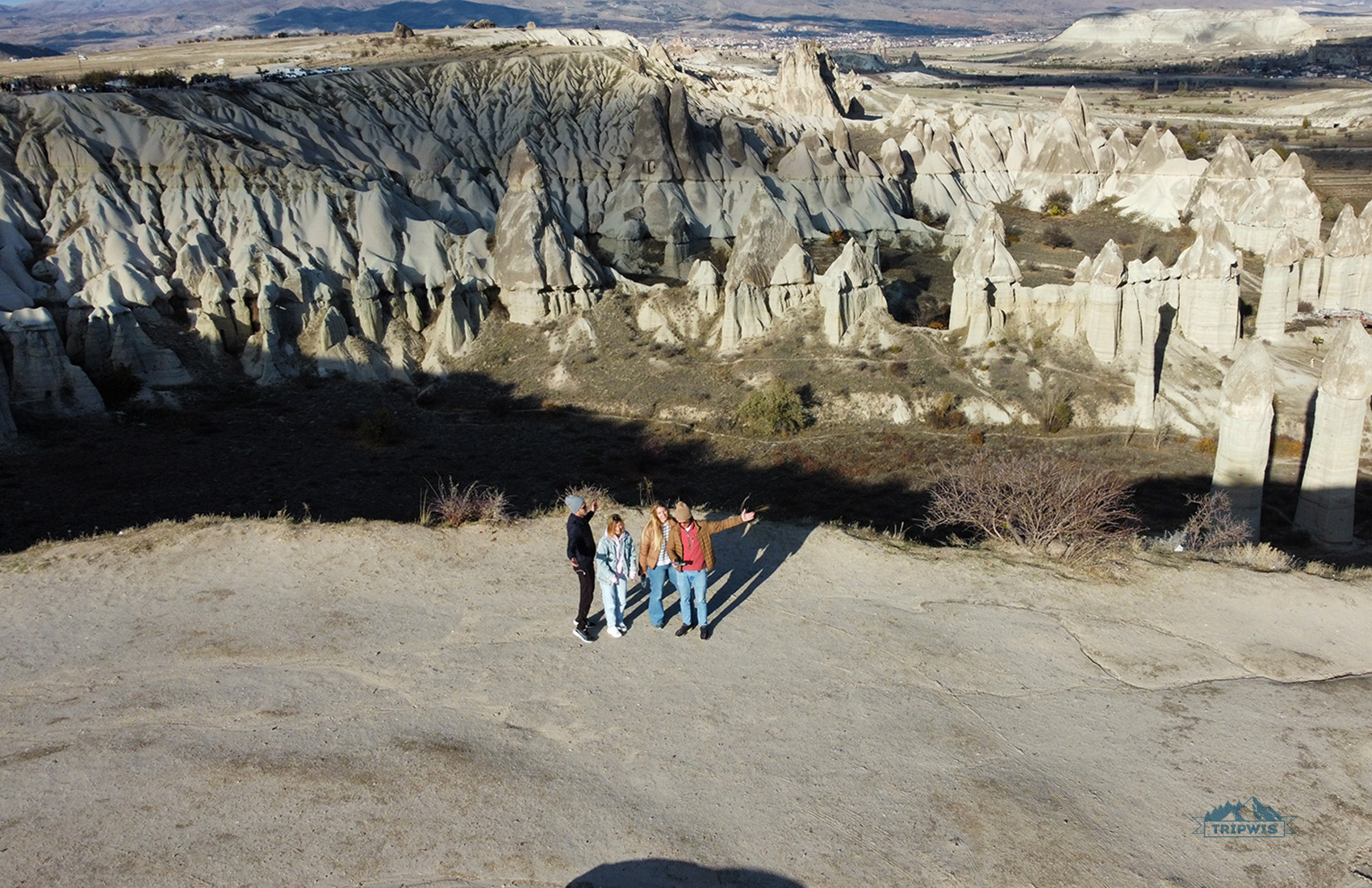
The most anatomically suggestive rock formations of the area call the aptly named “Love” valley their home — and you will not confuse this Cappadocia attraction with others of the same nature. The tall and slender phallic shapes grow tall amid the sprawling valley floor, creating a sight that inspires quiet smiles and tiny giggles from all who witness it.
You can gaze at the eroticized pillars from the Love Valley Panoramic View point, or get closer and crane your neck at these towering giants by embarking on the rocky trail. If you crave something a little wilder and more adventurous, consider renting an ATV and zipping through all the twists and turns of the dramatically beautiful valley at full speed. Go ahead and book it in advance — this particular tour covers Rose and Red Valley as well.
Cappadocia’s Love Valley is at its most magical at sunrise — if you think that the Göreme balloon viewpoint is too mainstream, consider coming here to witness the morning sight of these colorful balloons lifting from the ground and slowly ebbing and flowing in the air.
Spend a late afternoon at Red and Rose valleys
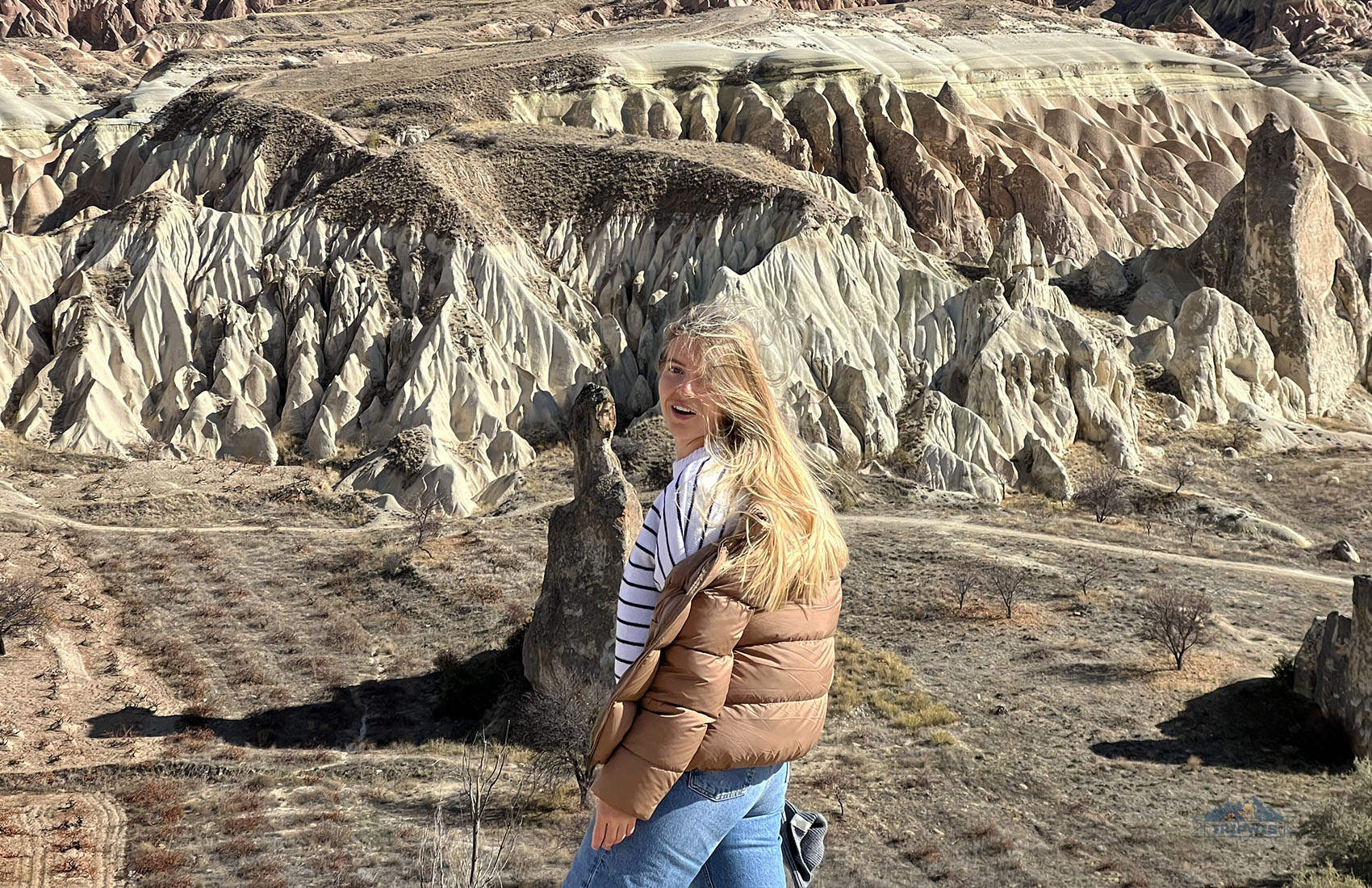
I could spend days praising Cappadocia’s honey-colored landscapes, but let’s be real for a second: After a while, they all get too beige-mom-ey for our taste!
The uniquely shaped terrain is the area’s bread and butter, but when it comes to color, the sand stone majorly drops the ball. That is why I felt so elated when I found out that you can actually witness some real color here other than oatmeal- or camel-hued rocks.
What not to miss in Cappadocia if you are looking to zhuzh up your photo game with some colorful oomph? Red and Rose valleys, of course! The names are very on the nose — some particular stone minerals make for red and rose tints of the landscape. Due to lesser foot traffic (though you will never be alone, Cappadocia is a very popular tourist destination), you might feel like Indiana Jones — tracking down the early Christian frescoes in deep caves.
Keep in mind that if you visit the valleys around noon, you will not be able to see the color of the rocky formations that earned them the names. Though early morning is an okay time, it is best to head towards the valley trails in late afternoon: With every passing hour, the backdrop will show more and more of its real tones.
After seeing the color change myself, I think that the names of the valleys are too simplistic: The Rose Valley’s hues aren’t pink — they are more coral and salmon. Same here with Red Valley: At peak sunset hours, the fiery palette is vermilion at best, but mostly it is ochre and russet.
Pay a visit to Çavuşin and its Zelve Open-Air Museum
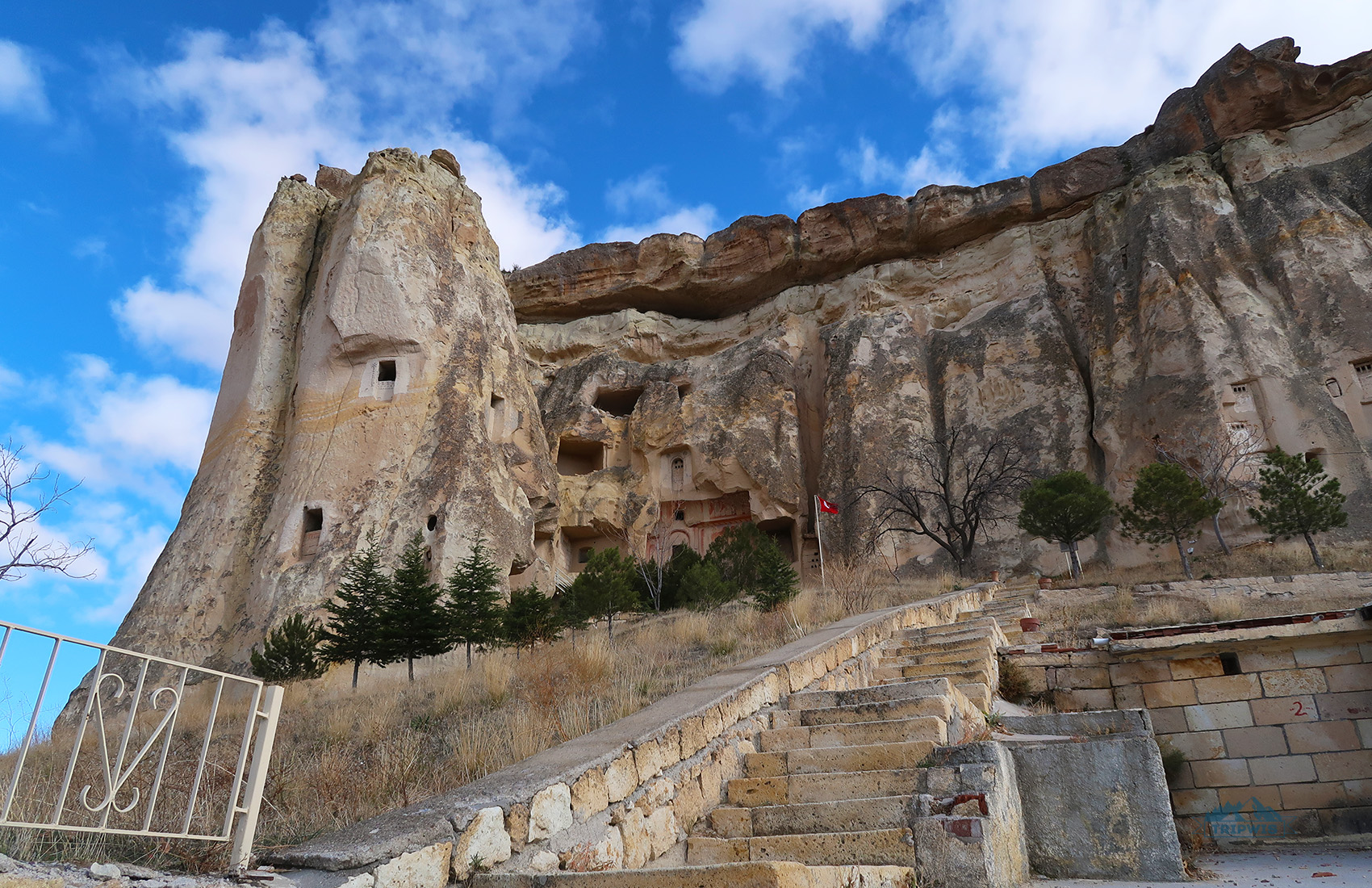
Moving north from Göreme, one can come upon a quaint village of Çavuşin — just a mere 10-minute drive promises a more authentic and meditative experience for all who come here.
Remember how I mentioned that erosion and time will inevitably change the Cappadocian landscape? Well, in Çavuşin, this process has started decades ago: Take Zelve Open-Air Museum, for example. The residents of this community were forced to move away from the area in the 1950s because of the high risk of the structural rock collapses. Now, when you visit Çavuşin Castle, you can see the slow and steady natural destruction.
Çavuşin Church has been closed for renovation for years now. When it opens, be the first to see it’s well-preserved frescoes — it is no wonder that the church is one of the most significant (and oldest) religious sites in all of Cappadocia!
If you make the trek to Çavuşin, then you can’t not visit Zelve Open-Air Museum — it is more serene and atmospheric, almost completely abandoned. Here, you won’t find railings and information stands — you’re free to wander around, ducking in and out of cave dwellings, circling fairy chimneys, and generally finding spots of respite where you can stand still and take the scenery in.
If you’re a first-time Cappadocia visitor, I would recommend sticking with visiting Göreme Open Air Museum — it is more structured and user-friendly. Zelve is wilder, there’s less distance between you and the history of the place, which can feel overwhelming to someone who lacks foundational knowledge of the area.
Zelve Open-Air Museum entry fee: €12 (but you pay in lira according to the current exchange rate)
Parking: Free
Opening hours: 8 a.m. – 8 p.m.
Look into the magic of fairy chimneys at Pasabag Valley
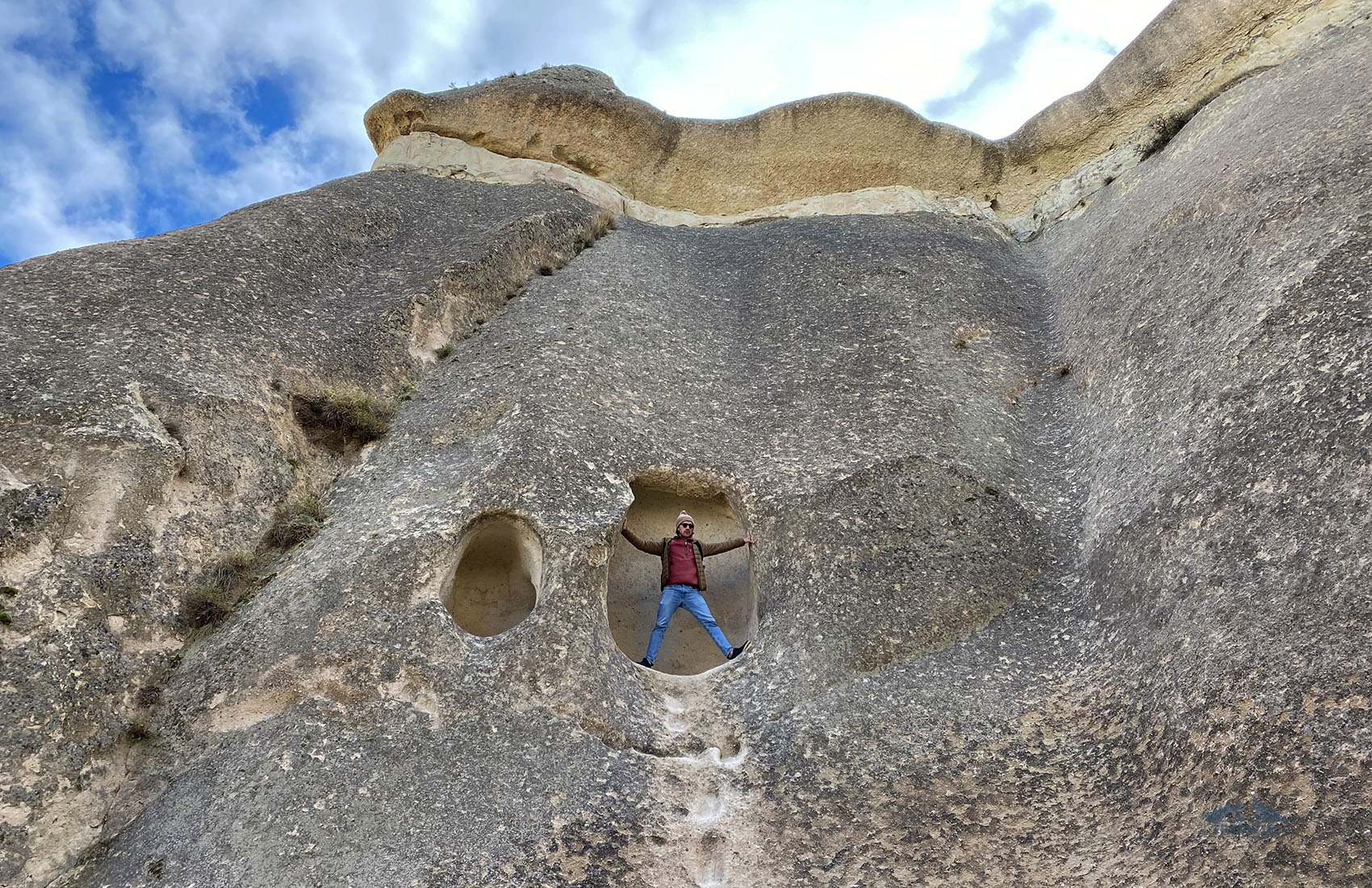
Not too far from Zelve Open-Air Museum sits another iconic Cappadocian attraction — Pasabag Valley. Also known as Monks Valley, this attraction is a fan favorite among tourists.
Why such a demand? You can tell from my list alone that there are plenty of other places in Cappadocia that have towering fairy chimneys of all shapes and sizes. Why is Pasabag Valley so special? Well, I’ve tried to answer the question rationally, but what I found was based on pure vibes — the sight of the mushroom-shaped rock houses is straight out of a fairy tale. You will catch yourself looking for Tinker Bell’s fairy dust trail or trying to hear the pitter-patter of Snow White’s dwarfs — Grumpy and Sleepy hiding behind the next path turn.
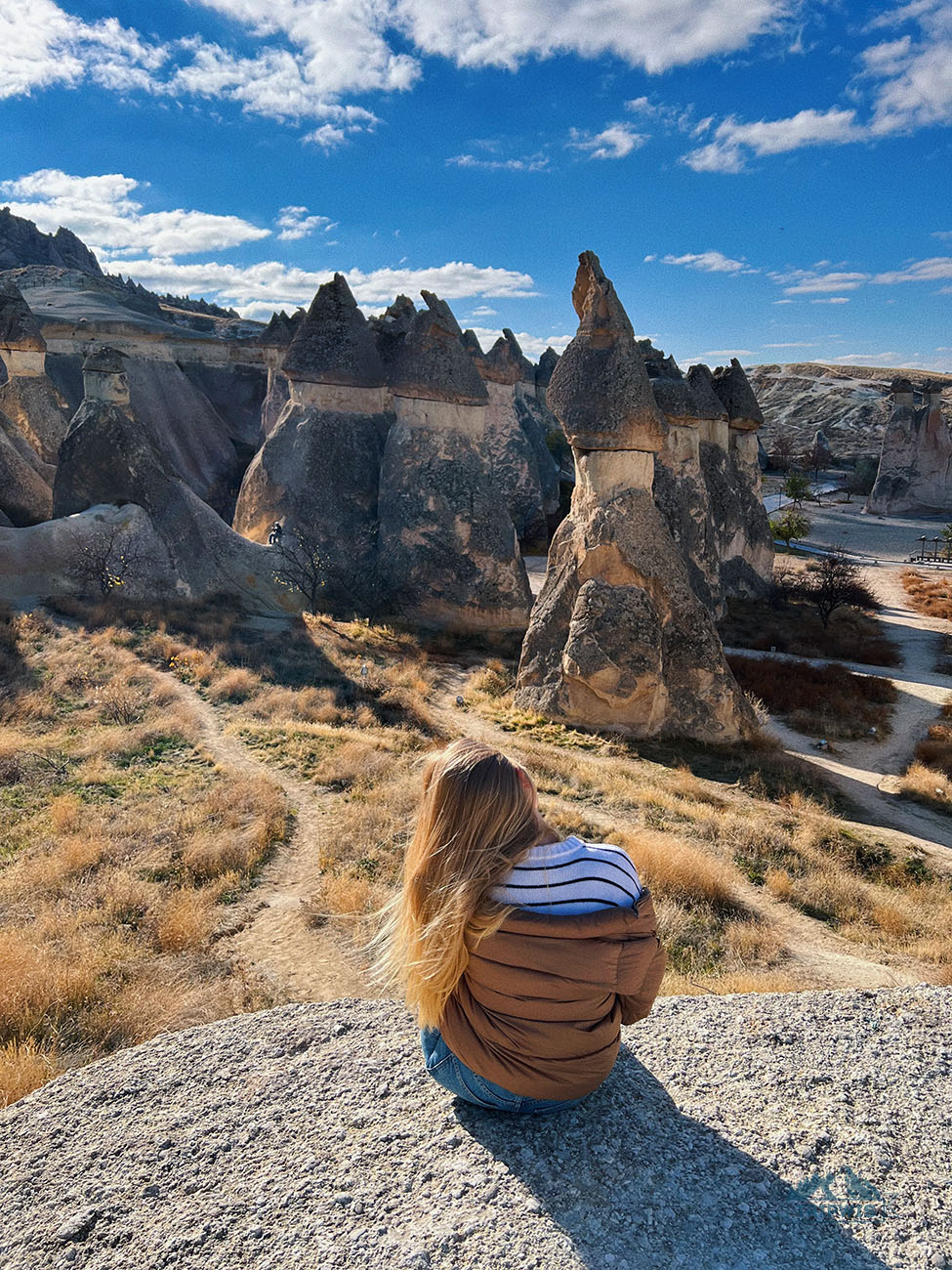 |
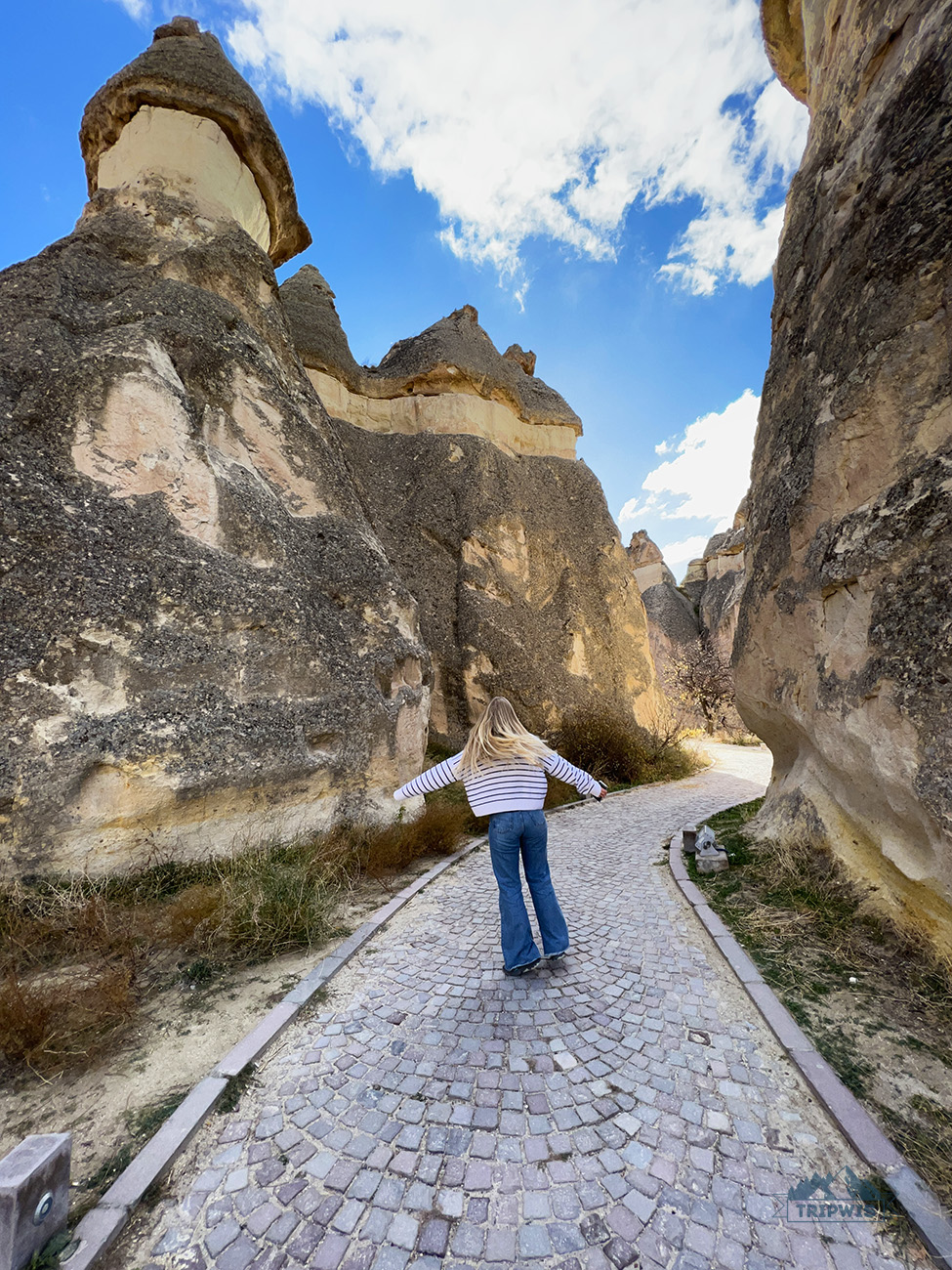 |
When comparing the conical rock structures to those of Love Valley, you will see the appeal of Pasabag — their base is wider, with gentler slopes, and the unique caps look like they’re precariously balancing on top of the pillars (only an illusion, of course, they are pretty sturdy). The rock-cut cave dwellings of old-timey hermits (St. Simeon being the most famous name; rumor has it that he could perform miracles and had to move to a fairy chimney to escape the crowds of people asking for help) are very well-preserved here, inviting you to explore their many rooms and cave labyrinths first hand.
The well-marked trails, the clear signage, the many viewpoints with panoramas of the entire valley, and freedom to explore at your own pace — if I had to choose three locations to see in Cappadocia, I would pick Pigeon Valley, Göreme town, and, without a doubt, Pasabag Valley.
Entry fee (you can visit Zelve Open-Air Museum with the same ticket, which is great): €12
Parking: Free
Opening hours: 8 a.m. – 8 p.m.
Follow the river at Ihlara Valley

The most remote attraction on my list, Ihlara Valley is set 90 kilometers away from Göreme but it’s so worth the ride! It looks as if Yosemite National Park was plunged onto the floor of Arizona’s Grand Canyon, which is a crazy visual, but it rings true here!
Stretching for 14 whole kilometers, Ihlara Valley is dramatically different from all the valleys we’ve experienced in Cappadocia. First, it is set deep (and I mean DEEP) in the natural gorge — the deepest part reaches 100 meters in some places. Second, it is green: The river means life, and the many trees, bushes, grass patches, and wildflowers are the proof. No wonder that Ihlara Valley is one of the most popular hiking destinations in Cappadocia, especially in late spring and early summer.
Side note: I would discourage travelers from visiting the valley in winter and late fall, since the vegetation is scarce during this time. Plus the foliage of the particular trees (mostly poplar trees) that grow in the canyon doesn’t turn pretty shades of orange and red — it just kind of loses color, which is not a picture-perfect sight.
As is the case with most of Cappadocia, Ihlara Valley isn’t the exception to having rock-cut churches with Christian frescoes still intact. The most beautiful cave church in the valley, in my humble opinion, is the Ağaçaltı Kilisesi (Church Under the Tree) — it has one of the most mesmerizing ceilings I’ve seen in preserved Cappadocian churches.
Since it is remote, you need to carve a lot of time to visit Ihlara Valley. The hike alone will take up a bunch of hours — the official trail goes for 7 kilometers. Of course, most of the tourists don’t venture far form enter points and do short 1 to 2 kilometer loops in the immediate area.
Alternatively, you can do the hike in the early afternoon, and then use your evening to explore Derinkuyu Underground City — it will be on your way back to Göreme. There’s also one pitstop you could make between the two Cappadocian attractions — Narligol Crater Lake, which is a heart-shaped volcanic crater lake. It is not too exciting a destination to warrant a day trip on its own, but when paired with other places listed, it is an okay layover.
Entry fee (but you pay in lira according to the current exchange rate): €15
Parking: 60 lira / $1,5
Opening hours: 8:30 a.m. – 5 p.m.
Get claustrophobic at Kaymakli & Derinkuyu underground cities
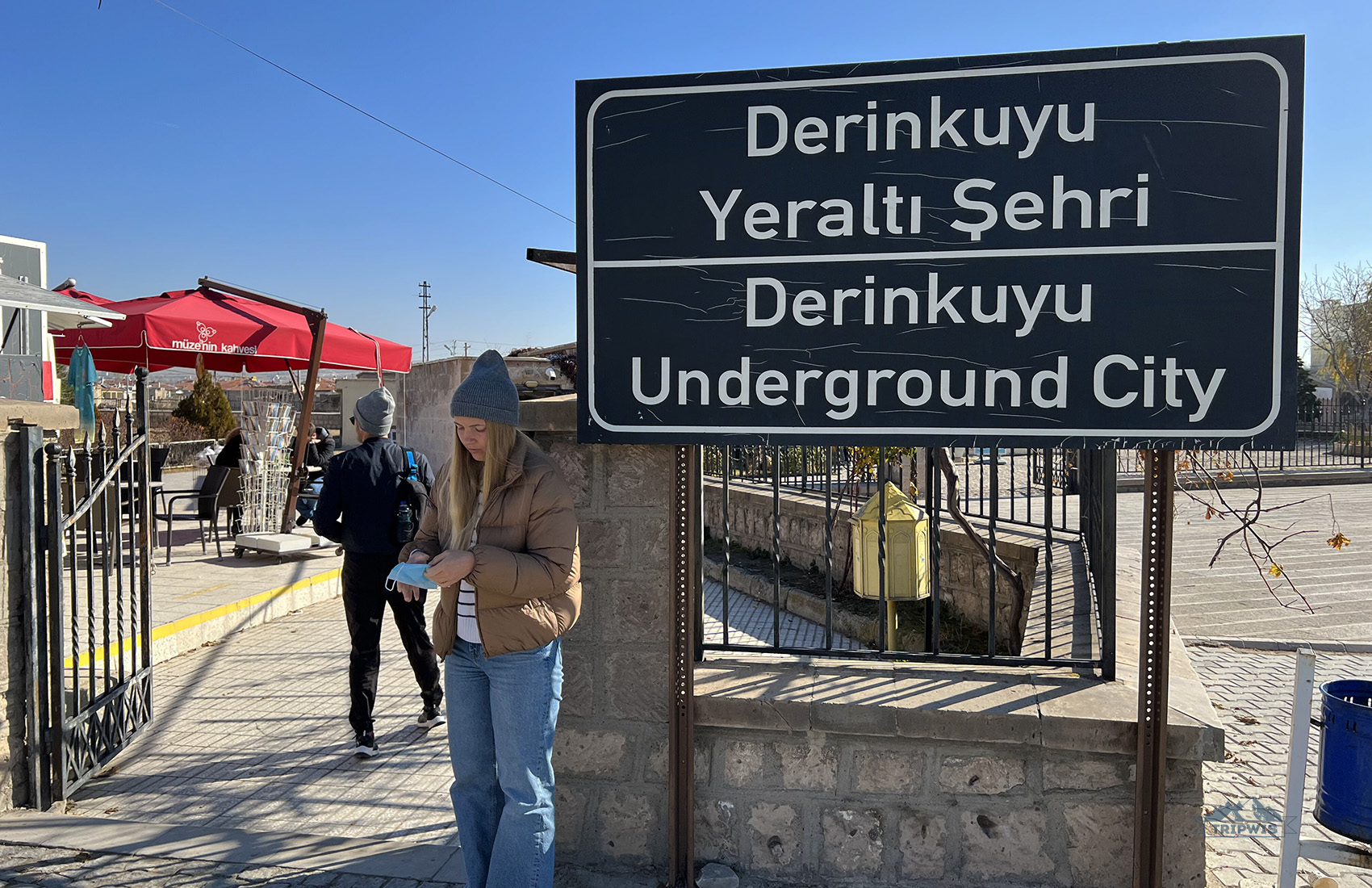
Various fairy chimney-clad valleys aren’t the only must-see attractions in Cappadocia — you cannot visit the region and not see the underground cities. There are quite a few of them here, but Kaymakli and Derinkuyu are the most popular ones.
Located within a 10-minute drive from one another (there is a tunnel connecting the two, but it’s not accessible to tourists), both underground cities can be visited in succession (that is, if you didn’t have a major panic attack in the first one and want to see more). Personally, I believe that if you’ve visited one — you’ve visited them all, so we picked Derinkuyu as our nerve-titillating adventure of the day.
Derinkuyu is set to go deep — there are eight levels that you can explore, the lowest one at 60 meters underground. At the time of construction (long before Christian prosecutions, the origins of the Cappadocian underground cities stretch to the Hittite era, BCE; but most of the expansion was made in the Byzantine era), it was a fully functioning city. It had multiple entry points that could be locked by giant boulders from the inside to prevent invaders from coming in, an intricate ventilation system, wells, churches, wineries, living quarters, and even a cemetery!
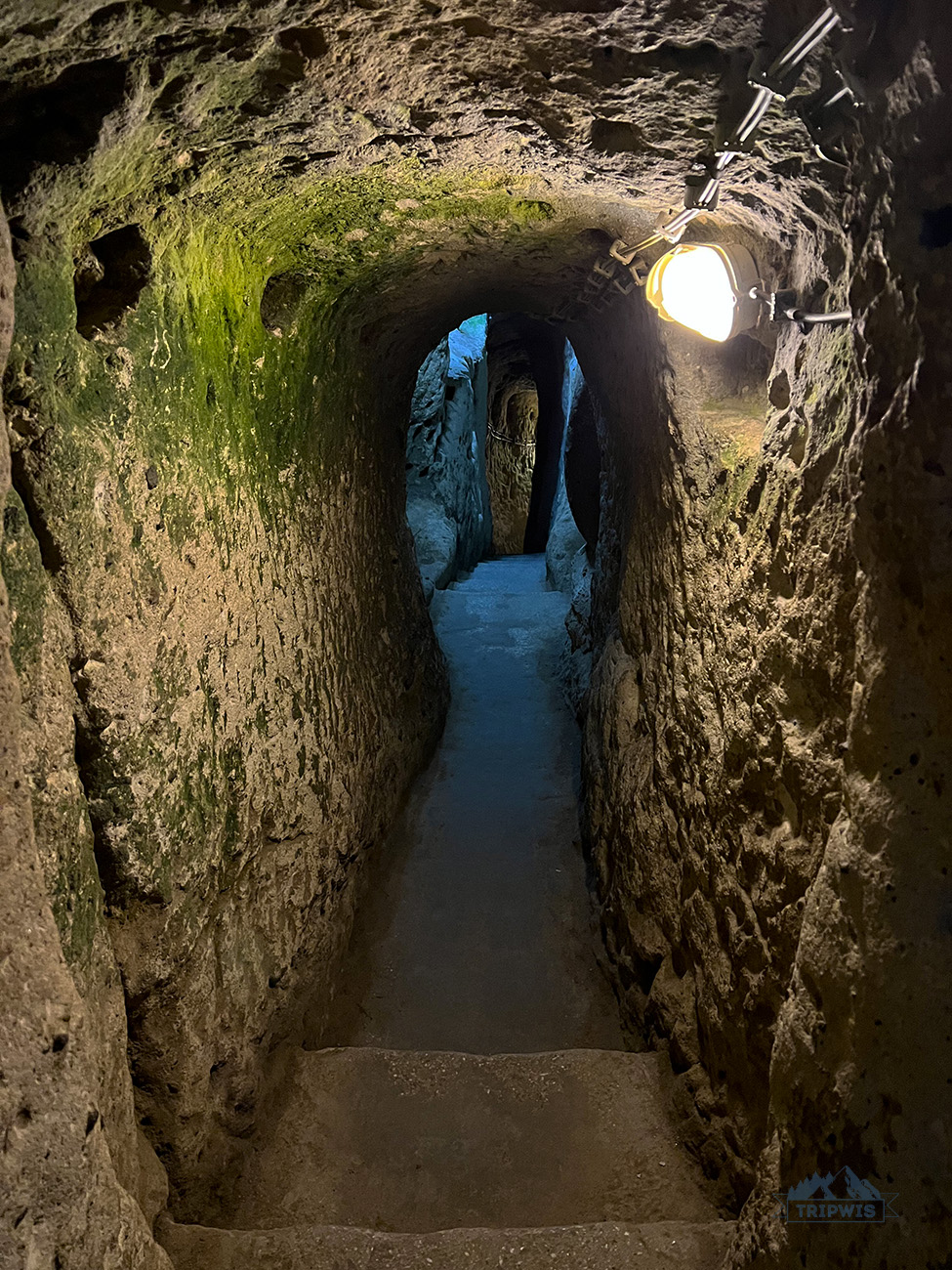 |
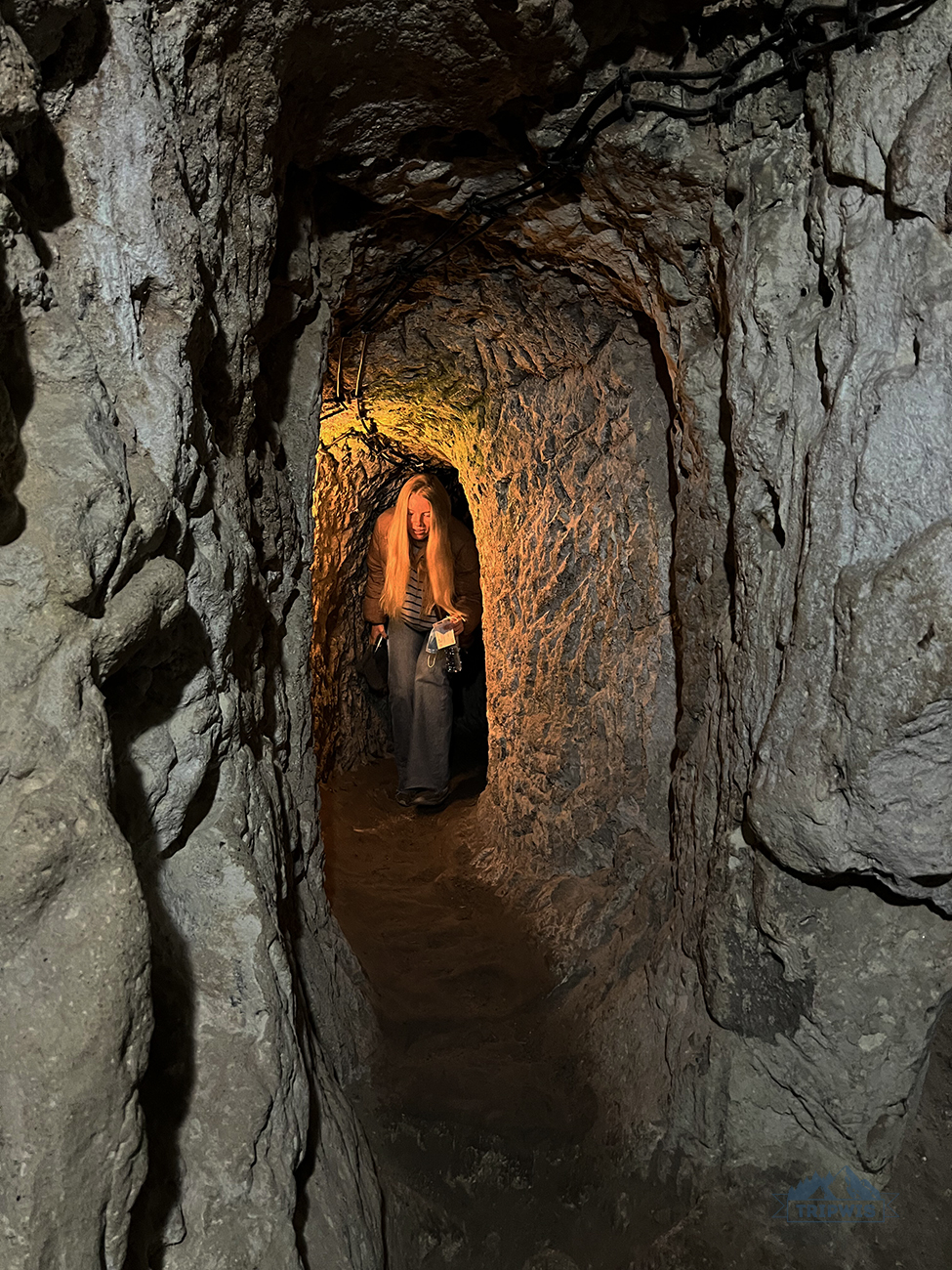 |
Side note: It is said that Derinkuyu could fit 20,000 people at its peak — the fact that gets crazier to believe in once you start descending closer to the eighth level. The passageways get narrower, the air becomes heavier, it gets colder — it’s hard to imagine people having to hide out here, with no sunlight and fresh breeze.
Keep in mind that even though both cities are well-lit and meticulously upkept, you can very well have an anxiety attack when going through the low and narrow tunnels here. There were places where we had to crawl on all fours!
The underground cities of Kaymakli and Derinkuyu are best explored with an organized tour. If you decided to rent a car in Cappadocia, then you could pop in for one last hoorah at either one on your way back to Antalya.
Entry fee at either one: €13 (but you pay in CASH lira according to the current exchange rate)
Opening hours: 8 a.m. – 6:15 p.m.
Find the best viewpoint in Cappadocia
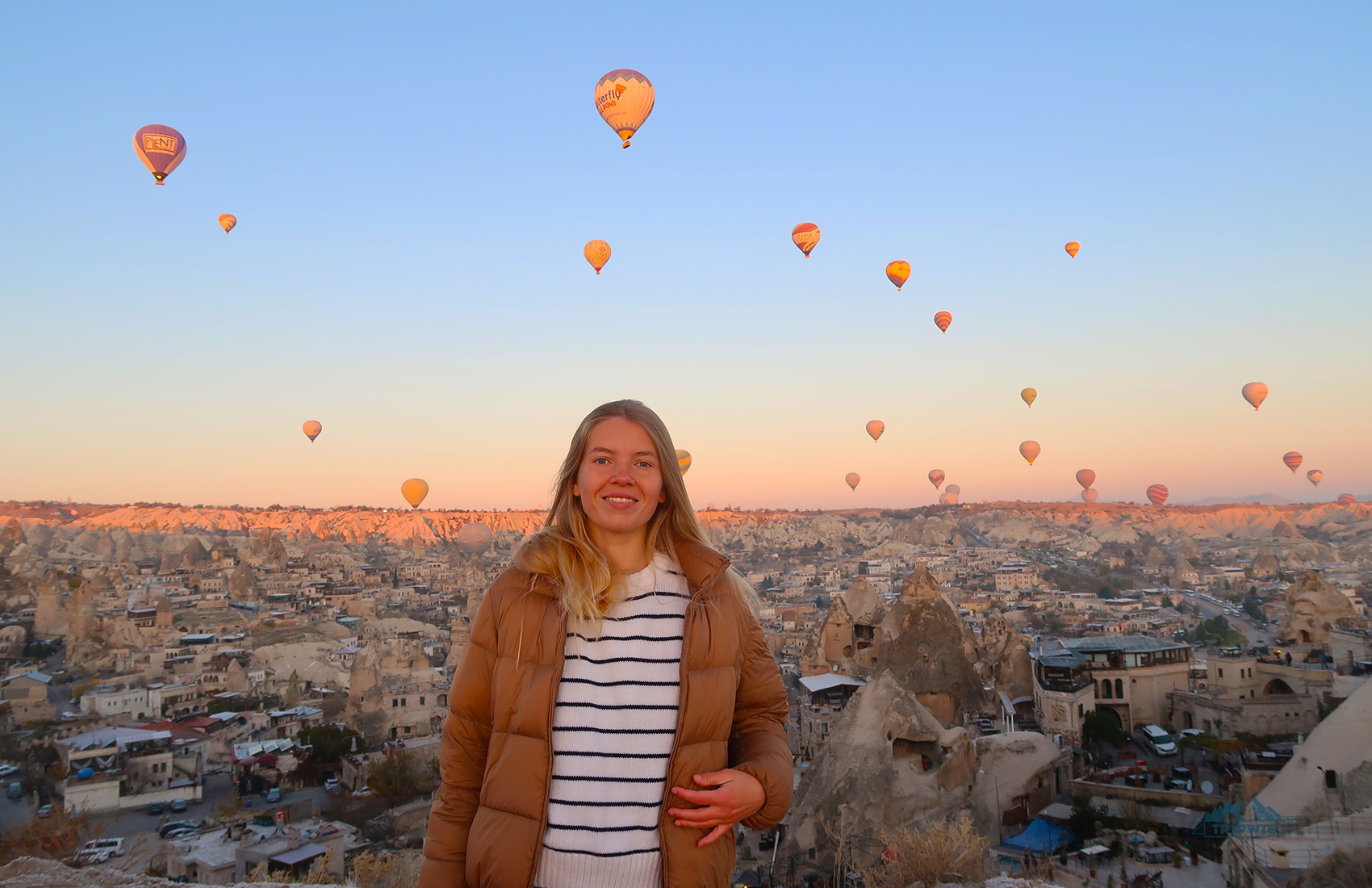
Truthfully, any point that stands out of Cappadocian landscape is great for admiring the stunning panoramas. However, when such tourism hallmarks as bathrooms and food stalls are involved, as well as different scenery angles, there are some distinctions to be made.
These are the best viewpoints in Cappadocia (feel free to leave your suggestions in the comments at the end of the article) as they are marked on Googlemaps:
- Sunset/Sunrise/Balloons Highest View Point in Göreme — located within walking distance of the city center (mostly uphill), this is the most popular viewpoint in all of Cappadocia. With an entry fee of 30 lira, it comes with unbeatable views of both the town of Göreme and the valley where all the hot air balloons take flight. Come here thirty minutes before sunrise to snag a prime watching spot, and don’t forget a jacket!
- Salkım Tepesi Panorama — although there is no café anymore, the name lasts. You can see both Göreme and Uçhisar from this vantage point, which is super cool.
- Love Valley Panoramic View — once again, this is the view that will make even adults chuckle. With the anatomically suggestive panoramas come food and drink stalls — grab yourself a pomegranate juice or a coffee, but know that you’ll be paying much more than it is worth.
- Ortahisar Castle Viewpoint — Ortahisar Castle is one of the largest fairy chimneys in the region, though not many travelers are aware of it — all the focus falls on Uçhisar Castle. Come to the viewpoint to see the more raw and unique structure. The panoramas here stretch as far as Göreme, almost completely unbounded by the horizon.
Embark on one of the popular hikes in Cappadocia
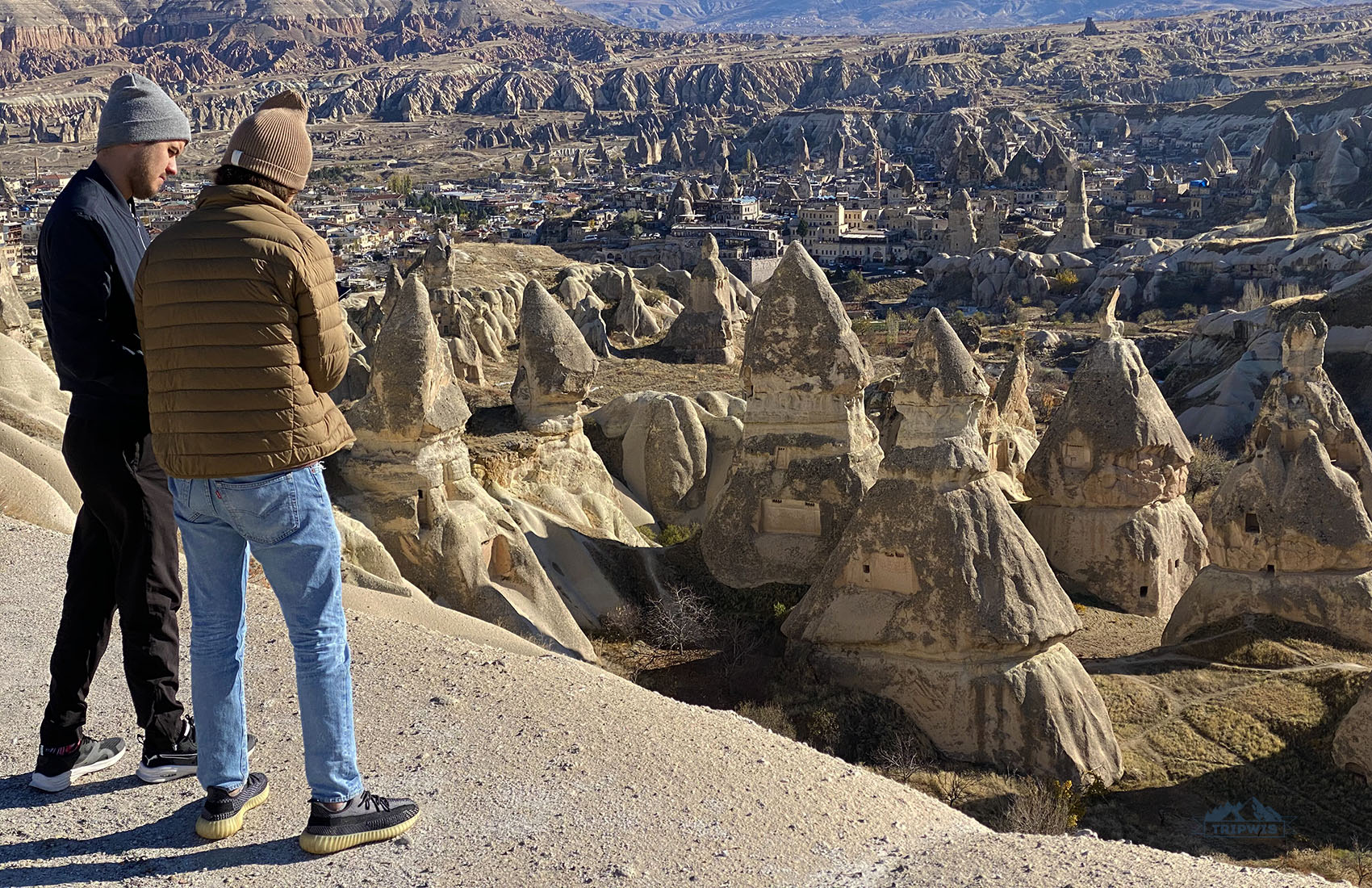
When you’re thinking of the best hikes in Cappadocia, chances are the trails will go through one (or more) of the region’s valleys.
There are two hikes that are on the top of everyone’s mind in Cappadocia:
- Pigeon Valley Hike — the trail is not for the novice hikers, since only portions of it are clearly marked, and the steep incline into the canyon requires great skill and attention. The views are great all the way through, but do tend to get repetitive closer to Uçhisar. The route is popular with hikers and mountain bikers, so you won’t feel alone and isolated when trekking the magical terrain.
- Rose Valley – Red Valley Hike — a smaller loop than Pigeon Valley Hike, this one is still pretty challenging. You’ll encounter plenty of cave churches on your way, so get ready to spend more time on the trail — at the end of the day, all those detours add an hour or so to the overall time count. Speaking about the end of the day, these valleys are famous for their unique tints that become more visible closer to golden hour and during sunset. However, plan your hike accordingly: You don’t want to get stuck in Cappadocian valleys after sundown — it gets harder to find your way.
Put a pin in other unique Cappadocian landmarks
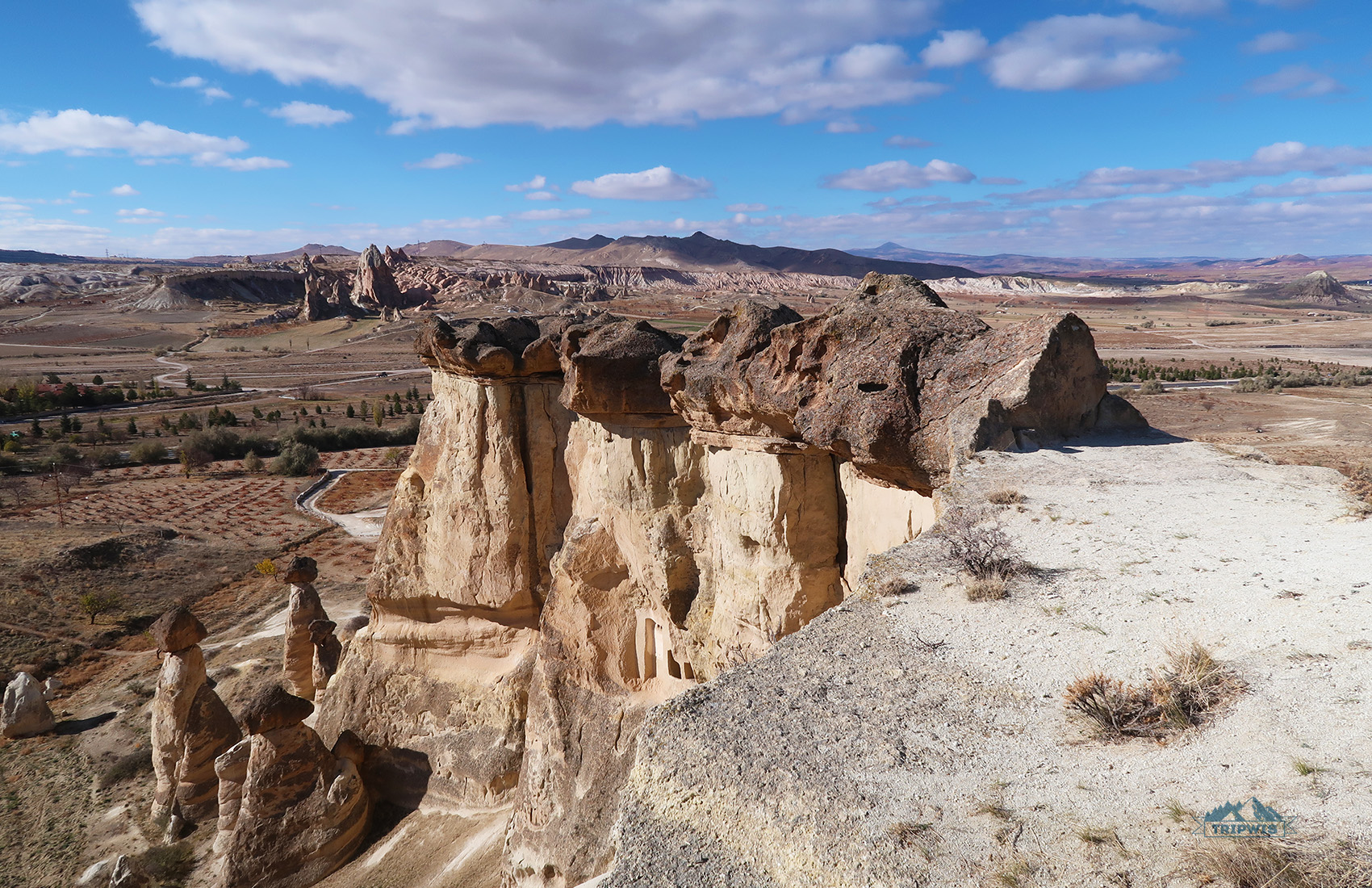
If you have some extra downtime in Cappadocia (it’s hard to imagine such a case, but maybe you decided to spend a week here and you ran out of things to see), there are a few other exciting attractions you can check out in Cappadocia:
- Al Nazar Church (or El Nazar Church, I’ve seen both being used) — also known as the Evil Eye Church, this abandoned religious dwelling is one of the more unique-looking rock-cut churches in Cappadocia. They say that it was used as a watchtower in its heyday, hence the name. Google says that the church is closed; and it does often have locked doors when you come here — just look for an older gentleman that is a keeper of the grounds, and he will open it for you. The beautifully preserved frescoes inside are worth the struggle!
- Lake Tuz, or Pink Salt Lake — technically located within an hour’s drive from Cappadocia, this tourist attraction still deserves a place on my list. It is exactly what it sounds like — a pink salt lake where you can take some the most creative photographs of your trip (and that’s saying a lot, after hot air balloons and fairy chimneys).
- Devrent Valley — also known as Imagination Valley, this area’s fairy chimneys turn a simple walk into a fun game — their silhouettes remind of camels, kissing birds, lizards, and other weird shapes. If you loved watching clouds as a kid, then coming here should be right up your alley.
- Guray Ceramic Museum — underground (!) ceramics museum located in Avanos. Come here for a chance to see hundreds of ceramic artifacts of different eras, all exhibited 20 meters below ground.
Get lost at Göreme Open-Air Museum
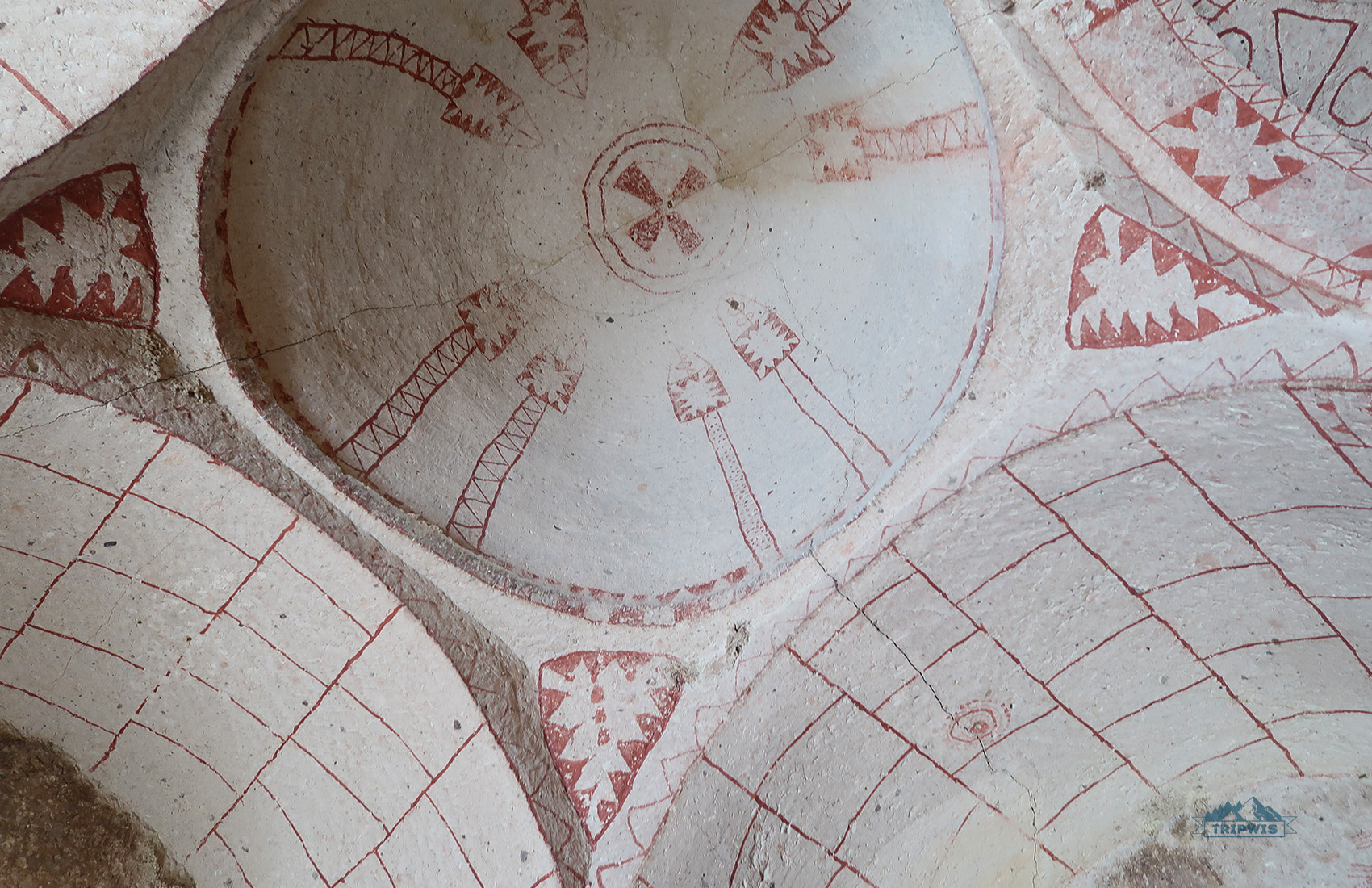
The second most touristy destination in Cappadocia is Göreme Open-Air Museum, and the fact comes as no surprise: After all, what good could a UNESCO World Heritage site title bring if not some human traffic to the area?
As if the location needed help with promoting itself: The iconic “fairy chimney” rock formations, the deep valleys, the cave-dwelling churches, and the overall magical aura bring in countless visitors every year. Some may refer to the area as a scaled-down Cappadocia, which is a perfect selling point for travelers who didn’t book a more thorough tour of the region’s top attractions or didn’t rent a car in Cappadocia.
The museum contains many important churches, chapels, and monasteries, but the most prominent ones are the Dark Church, the Apple Church, and the Snake Church. The Dark Church, the most famous religious site of the area, got its name simply from its original lack of windows — so, for its dark atmosphere. The dim setting worked wonders for the mosaics inside: They are still wonderfully preserved, and you can witness the Nativity scene as well as the Betrayal by Judas and the Crucifixion in all their colorful and soul-touching glory.
Though truly legendary, our visit to the Göreme Open-Air Museum proved to be a tad underwhelming… I know, what a sacrilegious thing to admit! Truth be told, after everything we’ve already seen in Cappadocia, the area’s celebrated landscape started to look repetitive to me personally. Come here if you like to nerd out on history and explore the crazy-old religious scenes — which are not our points of interest in the slightest, hence the apparent lack of enthusiasm on my part.
However, to each their own: And given the proximity to the town of Göreme (it’s just a short 15-minute uphill walk from the city center) and the attraction’s compact quarters, it’s no wonder that the Göreme Open-Air Museum is often described as the most prominent tourist site in Cappadocia.
Entry fee: €20
Dark Church entry fee: €6
Opening hours: 8 a.m. – 8 p.m.
Our 3 days in Cappadocia itinerary
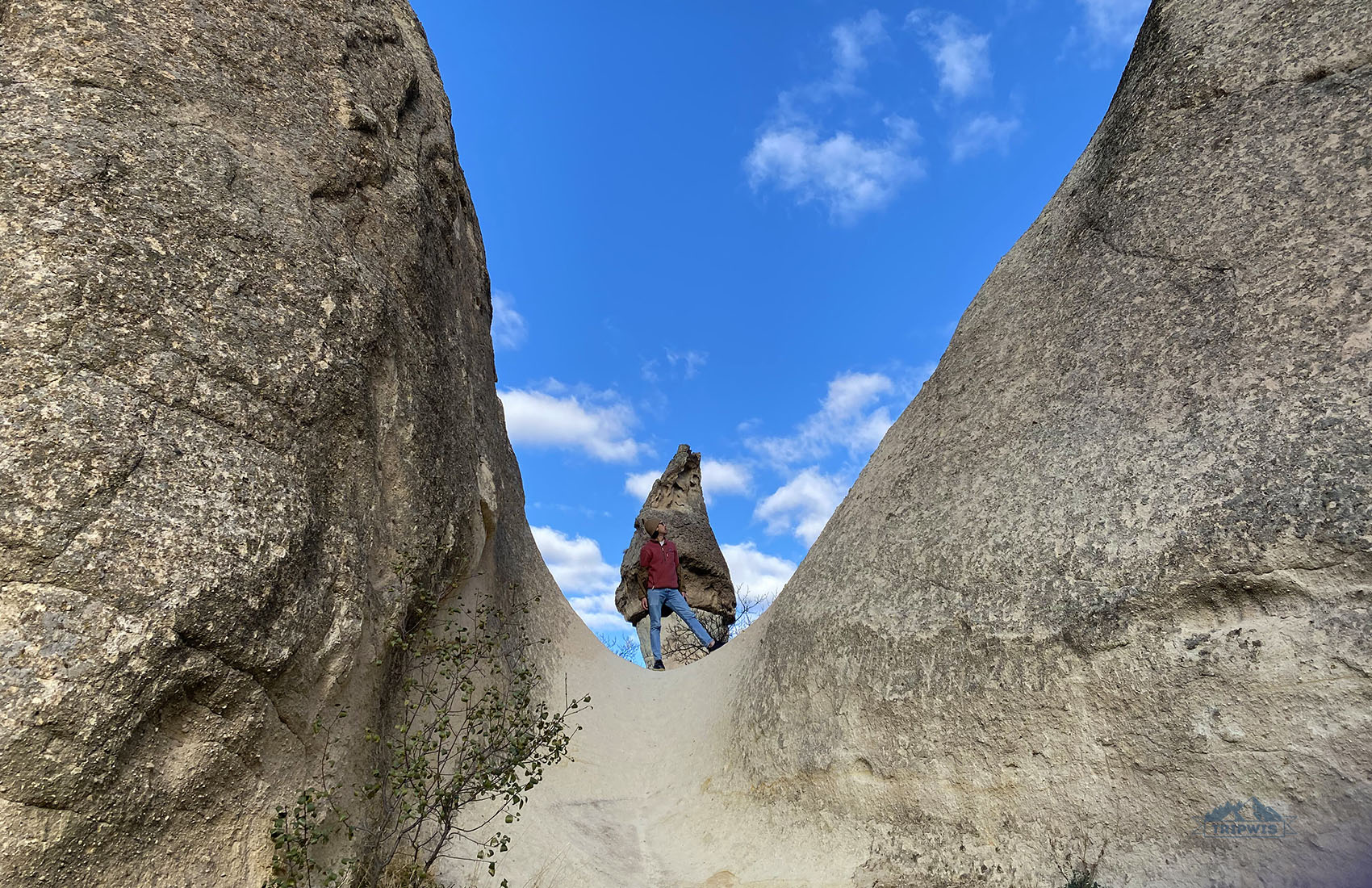
Though you’re free to mix and match the places listed above according to your time in Cappadocia, personal preferences, and energy levels, it’s nice to have a basic possible rundown you can modify to your liking.
Here’s how to spend 3 days in Cappadocia, Turkey:
Day 1
- Pigeon Valley — start your day to the stunning views of fairy chimneys. Maybe you’ll be lucky to catch the flock of pigeons on their morning flight — thus fulfilling this location’s entire purpose.
- Uçhisar Castle — stretch those legs by climbing the many stairs of the castle all the way to the top — you will be rewarded with yet another mind-boggling view of Cappadocia.
- Göreme Open-Air Museum (optional, and I would recommend skipping) — dive deep into the history of the region by exploring the many rock-cut churches and cave dwellings.
- Red Valley — watch as the rock formations change color the closer it gets to sundown; notice the ochre undertones coming out of boring sand-colored rock face right before your eyes. If you cannot wait that long, use the settings on your camera for desired effect — we won’t tell anybody!
- Horseback riding tour — meet the sunset while on the back of your new equine friend and watch the shadows change the scenery into an even more mystical sight.
Day 2
- Go on a hot air balloon ride over the Cappadocia landscape — the region’s calling card and bread and butter, an early morning flight where you greet the sunrise is an experience you’ll remember for the rest of your life!
- Ihlara Valley — since your day started super early (as are most days in Cappadocia), you can afford to spend some time driving to this green oasis set further away from Göreme.
- Kaymakli or Derinkuyu underground city — on your way back from Ihlara Valley, make a pitstop at one of the legendary Cappadocian underground cities. Explore the subterranean tunnels and dwellings and, if you’re not suffering from claustrophobia, venture to the lowest possible level — feel the cold damp air and discover cramped spaces people had to inhabit centuries ago.
- Pasabag Valley — end your day with a hike through the enchanted “rock forest” of the valley; climb into the caves carved in fairy chimneys, walk amongst the extraordinary rock formations, and simply have a good time — this day was so full of crazy experiences, it’s a good idea to end it on a dreamier note.
Day 3
- Göreme Sunrise Viewpoint — give yourself one more early morning to admire the hot air balloons as they float above the valley, this time as a spectator (one would argue that this experience is just as exciting, and in part, it’s true).
- Çavuşin and its Zelve Open-Air Museum — drive north of Göreme and find yourself in a quiet village with ruins and fairy chimneys that are just as interesting to explore.
- Love Valley — pay a visit to even more fairy chimneys, but this time put a little spin on the experience: Get an ATV tour and let your adrenaline guide you on the drive through the valley.
- Göreme town — since it’s your last night in Cappadocia, stay closer to homebase — walk along the town’s narrow winding streets and pop into a restaurant or two on your way back to the hotel.
Most popular Cappadocia tours
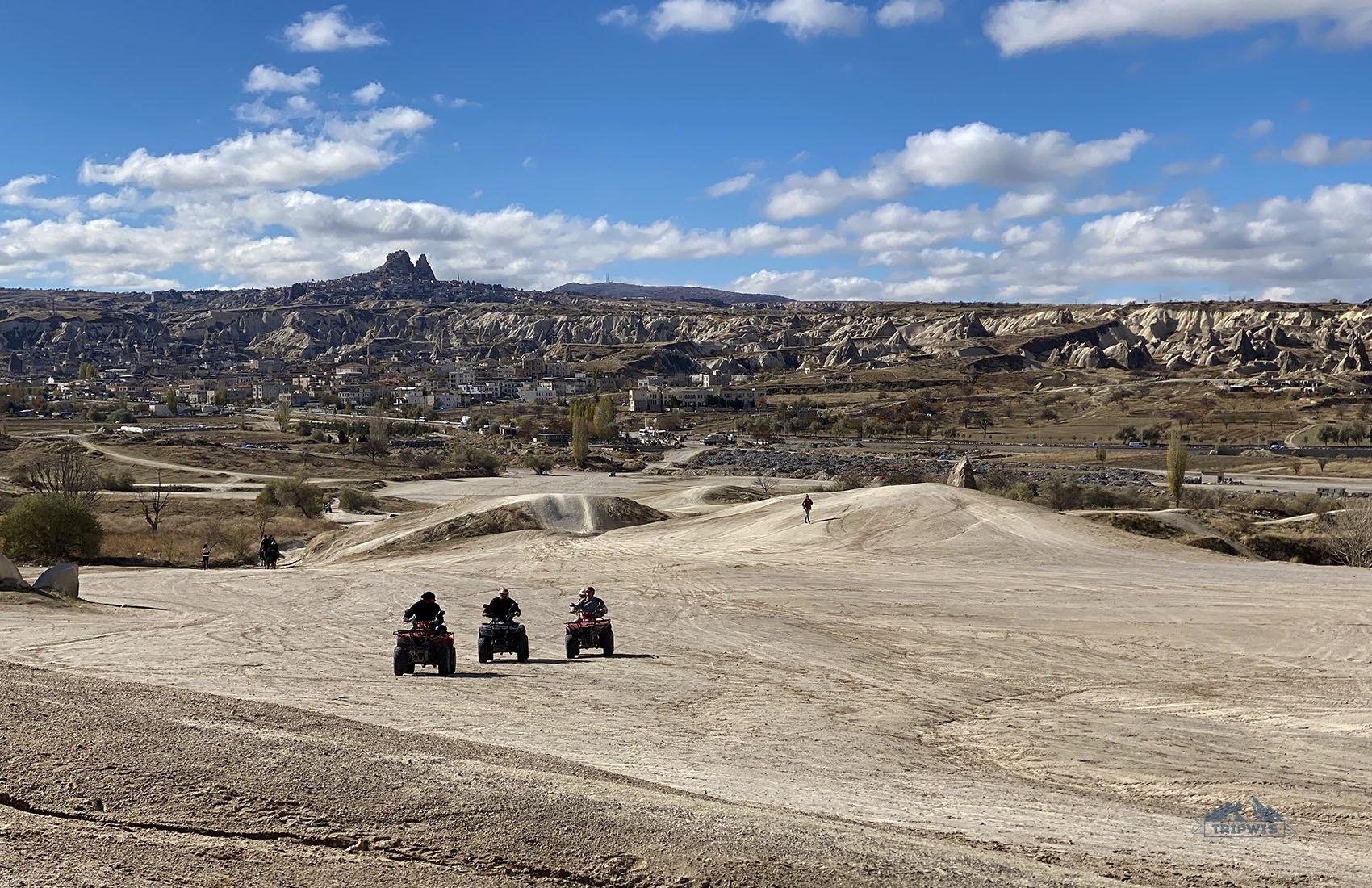
There are two main ways to explore Cappadocia: At your own pace, driving from place to place in your rented car, or with an organized tour. Local buses run only between cities, but most, if not all, notable landmarks are located outside city limits. Plus, public transport in Cappadocia in general is unreliable and almost non-existent in some more far removed destinations, so you can’t really count on it.
Since the area sees tons of tourist traffic year-round, there are already established routes you can look into and book a tour if you like what they’re offering:
- “Red Tour” (from $60) — covers Uçhisar Castle, Zelve Open-Air Museum, Pasabag Valley, Devrent Valley, Çavuşin, and Love Valley. This itinerary could theoretically be done without a guided tour or rented car (most of the landmarks are close to Göreme, some are even walking distance), but it will take twice as long and you’ll be super tired by the end of it.
- “Green Tour” (from $70) — the more exciting one; it covers such beautiful destinations as Pigeon Valley, Derinkuyu Underground City, and Ihlara Valley, among others.
If you have extremely limited time in Cappadocia, you can look into booking a full day combined Red and Green tour ⬇️ — it covers all the iconic sights, but is not too fast-paced. You will spend just enough time in each location to get a feel for the region’s rich history.
Turns out, there is a third color-coded tour — Blue Tour, but I only found out about it at the time of writing the article. It’s not as well-known or even well-reviewed, and it mostly focuses on Cappadocian valleys — which will become boring or repetitive after the second one.
Even if you decided to rent a car, you should still consider booking some of the must-do activities in the region. The most popular Cappadocia tours include (but are not limited to):
- Göreme Hot Air Balloon Flight at Sunrise — the experience most globetrotters come to Cappadocia for
- Sunset ATV Tour — perfect for those who prefer to explore the new terrain with a touch of adrenaline
- Horse Riding Tour — a fun time with some stunning views along the way!
Where to eat in Cappadocia?
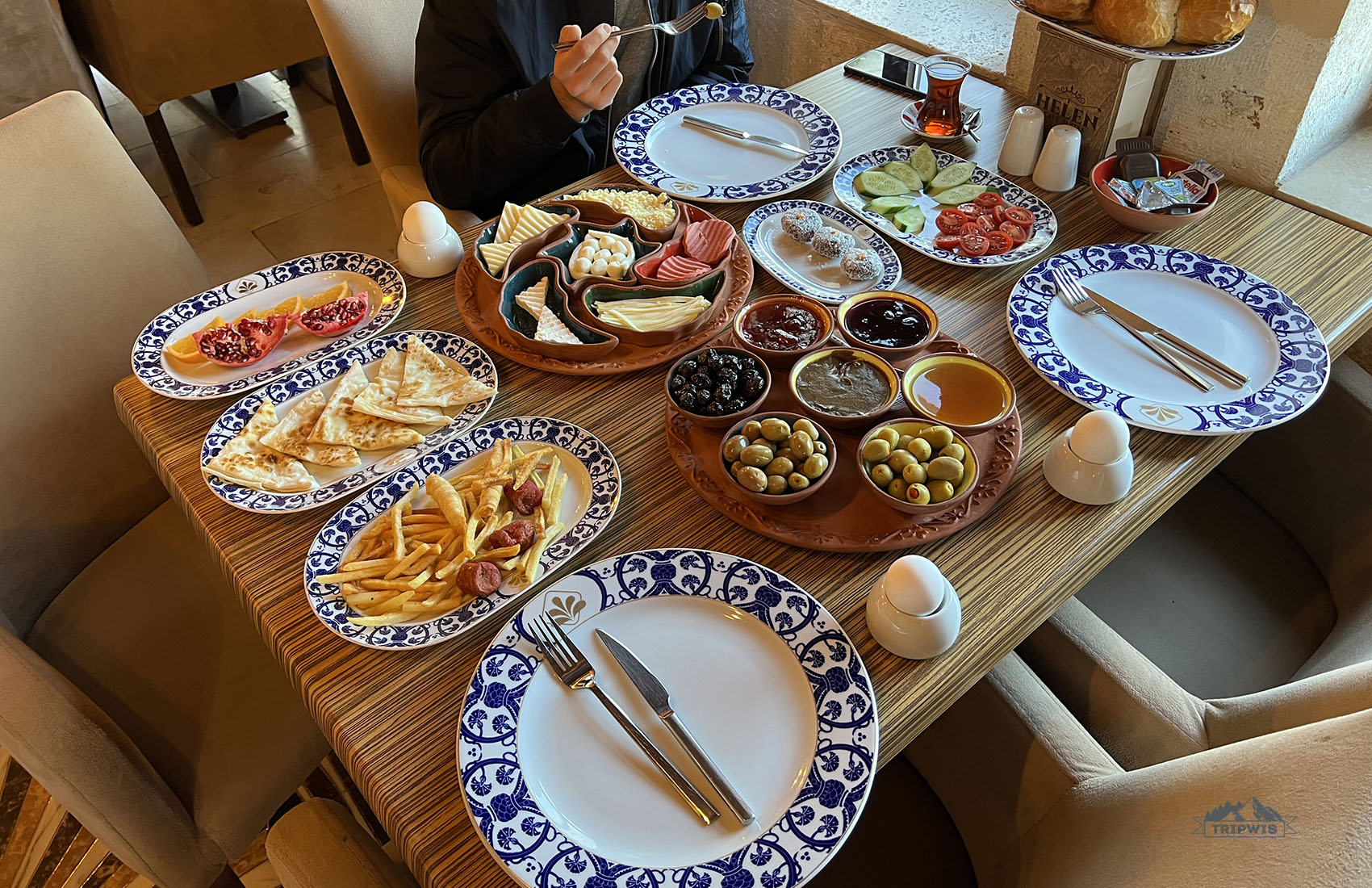
Göreme — the tourist center of Cappadocia — is no stranger to authentic establishments that serve delectable local recipes, as well as trendy-ish bars and cafes that have popped up like mushrooms (or fairy chimneys shaped like mushrooms?) in recent years.
However, you must keep in mind that the prices here will not be small-town-level. Even though the area really is pretty compact and intimate, it is way too touristy and far removed from major supermarkets to be cheap.
- I strongly advise you book a hotel with the breakfast already included. That way, you’ll have one meal of the day already taken care of. Besides, breakfast spots aren’t really what Cappadocia does best.
Have some of your travel budget allotted specifically for trying local specialties at great eateries (no matter the price). After all, eating out at a new place is a very Bourdain-coded way to get closer to understanding it, and patronizing a new restaurant can be considered one of the most obvious things to do in Cappadocia at night — there’s not much else to experience here once the sun sets below the horizon!
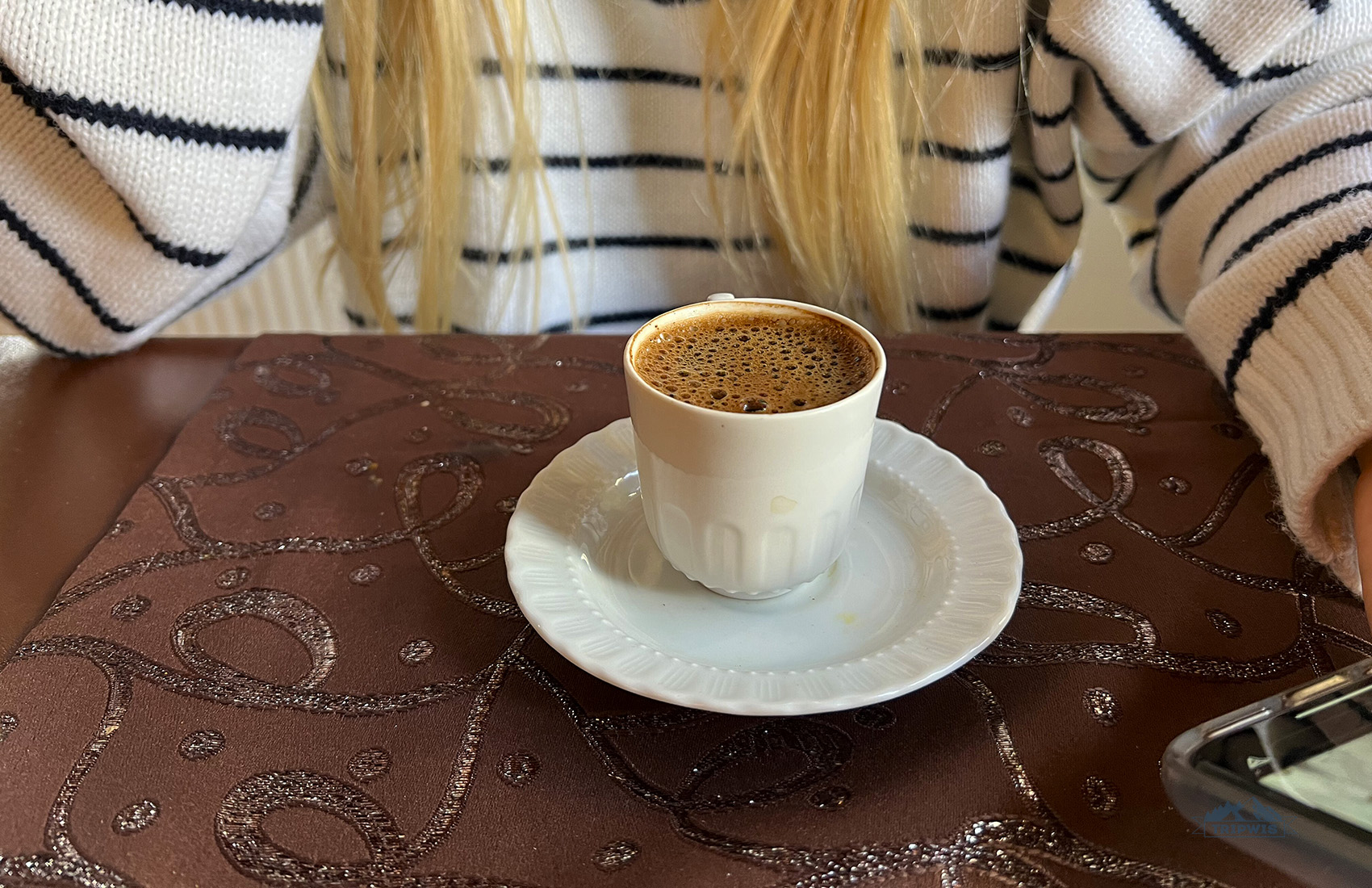
Here’s my tried-and-tested list of places to eat in Göreme, in no particular order:
- King’s Coffee Shop — my personal favorite coffee shop in all of Cappadocia; it has the best (non-specialty, but still) coffee in Göreme and the most friendly and welcoming owner ever. Shoot to spend about 190 lira / $4,8 on a cup of cappuccino. Also! This is where I tried sahlep — a traditional Turkish warm milky drink made with orchid flour, with optional flavors.
- Turkish Ravioli Restaurant — the best manti in Cappadocia! A regional specialty and a distant cousin of ravioli, manti are pinky-sized meat-stuffed dumplings that are usually topped with some kind of yogurt-based sauce. They were particularly good at Turkish Ravioli Restaurant, same as their pasta (not very Italian, taste-wise, but still great; worth the 500 lira price / $12,5).
- Sedef — Cappadocia’s hottest reservation that can feed even the pickiest of eaters! From pasta and salads that get the bases covered, one could move on to something more adult/adventurous, like testi kebabs (650 lira / $16) paired with a glass of local wine (300 lira / $7,5). The restaurant is packed for breakfast, lunch, and dinner — a sign of tasty food and excellent service!
- Quick China — you would not expect to find a safe haven for Asian cuisine lovers in the heart of Cappadocia, but here it is: Quick China serves amazing Chinese, Japanese, and Thai dishes. Rolls, noodle dishes, dim sum, poke bowls… try and not get decision fatigue from their expansive menu (priced at 450–550 lira for a dish / $11–$13,5)!
Things to know before coming to Cappadocia, Turkey
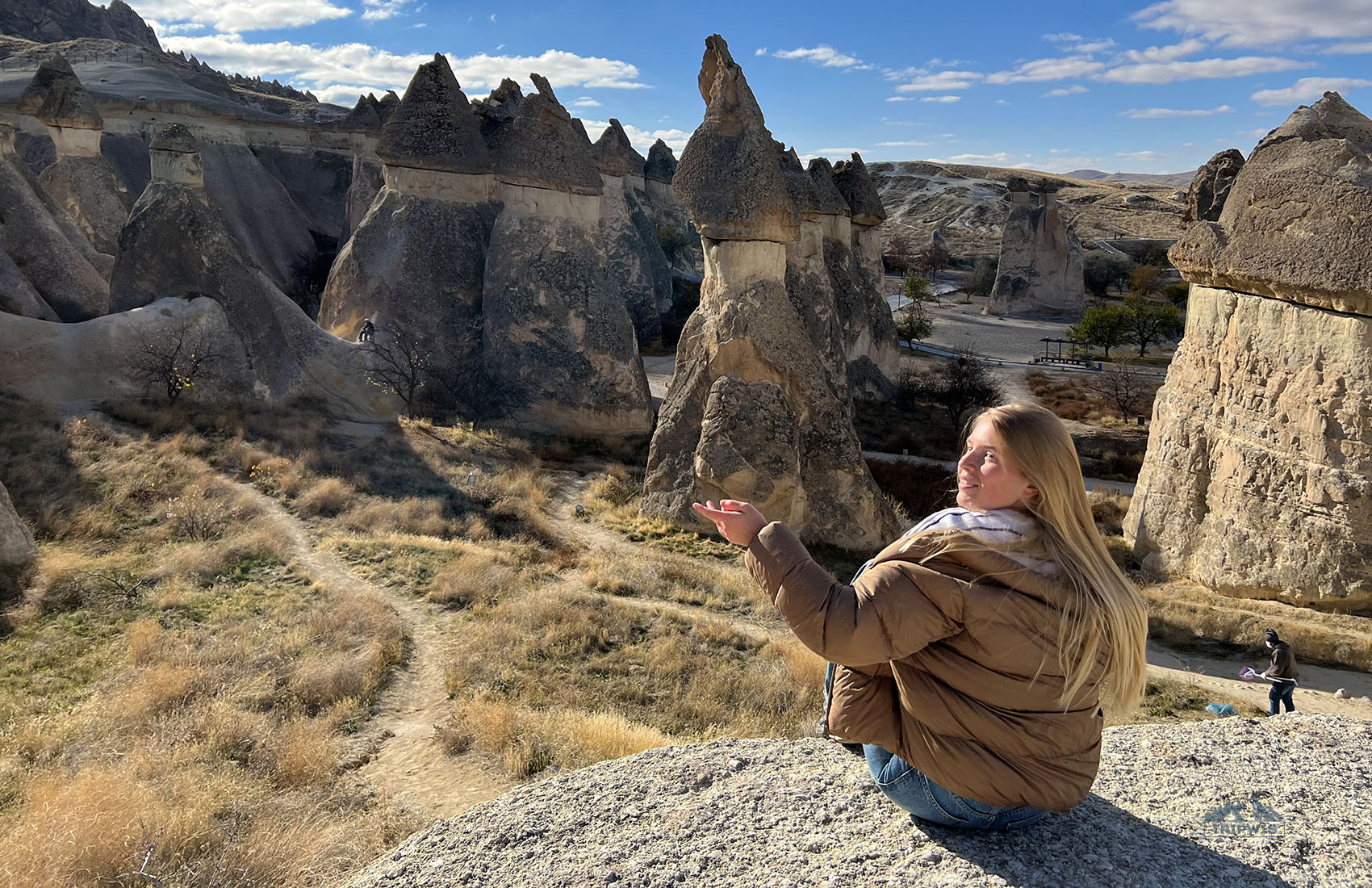
Cappadocia is second-most written about place in Turkey — losing only to the country’s capital, Istanbul. And with good reason — I think that every person that comes across pictures of the Cappadocian landscape paired with countless colorful hot air balloons gets major FOMO and wants to experience the dream themselves. Hence the frantic search of key words ensues: From where to stay in Cappadocia to what to do in Cappadocia (and particularly how to ride in a hot air balloon in Cappadocia). Demand creates supply, so hundreds of articles flood the search results — some with good advice, some with bad, and, of course, the one you’re reading right now, which is absolutely perfect in every way (I hope).
No self-respecting Cappadocia travel guide can be complete without giving you a list of things to keep in mind before traveling to this magical place, so here it goes:
1) If you have a driver’s license, then by all means, rent a car in Cappadocia! We’d hired a car on Localrent and it made our life so much easier here and let us see more of this region’s iconic sites. Remember Ihlara Valley? Underground cities? If you don’t want to be tied up with rigid guided tour timetables, then driving to these legendary landmarks yourself is the way to go.
2) Two whole days and a third morning is more than enough time for Cappadocia — you’ll have some wiggle room for bad weather balloon flight delays and plenty of downtime to visit a few of the region’s most exciting tourist attractions. Keep in mind that they can get repetitive (the second or third valley won’t have the same “wow” effect the first one did), so pick and choose activities that do not look the same — visit an underground city, then hike in the valley, go to an open-air museum, finish off the day by watching the sunset from the rooftop restaurant… you get the picture.
3) If you do not get claustrophobic and can handle spending prolonged time in a dimly lit room, then book a suite at one of the many cave hotels in Göreme. It is such a novel experience — “roughing” it (with all the necessary hotel amenities, but still) the way the hermits did centuries ago. Most of the cave hotels have outdoor terraces with unbeatable views of hot air balloons — it literally cannot get any better than this!
4) Book your hot air balloon ride way in advance — I’m talking at least two weeks, a month is even better. Come spring, the spots tend to fill up fast, so try and be proactive with your planning and booking.
5) What to pack for Cappadocia? Layers, layers, layers — even in warm summer months. Do not forget, all the hot air balloon rides start at sunrise, and it’s still a bit chilly at dusk. Winter shenanigans in Cappadocia basically scream puffer jackets, gloves, and hats, — plan your travel wardrobe accordingly.
6) Local businesses, especially in high-traffic areas (valleys, castles, open-air museums) tend to take advantage of their setting and tourists’ rookie oversights, price-wise — if you do not bring a snack or a water bottle with you, plan to spend more to satisfy your basic needs.
7) How much money do you need for Cappadocia? It all depends on how modest or lavish you were planning to get! If it helps, we straddled the middle ground between the two camps the last time we were in Cappadocia (our trip lasted 3,5 days), and here’s what we spent there:
*all the prices have been updated with regard to Cappadocia, Turkey’s increased prices in 2025
— car rental for 4 days = $140
— gas = $50
— hotel room with breakfast included for 3 nights = $390
— hot air balloon ride = $200
— other expenses, like parking and various entry fees = $80
Take this, then add food, souvenirs, and other miscellaneous purchases and you get something close to $1,000 (and this is without airfare costs).
Best time to visit Cappadocia
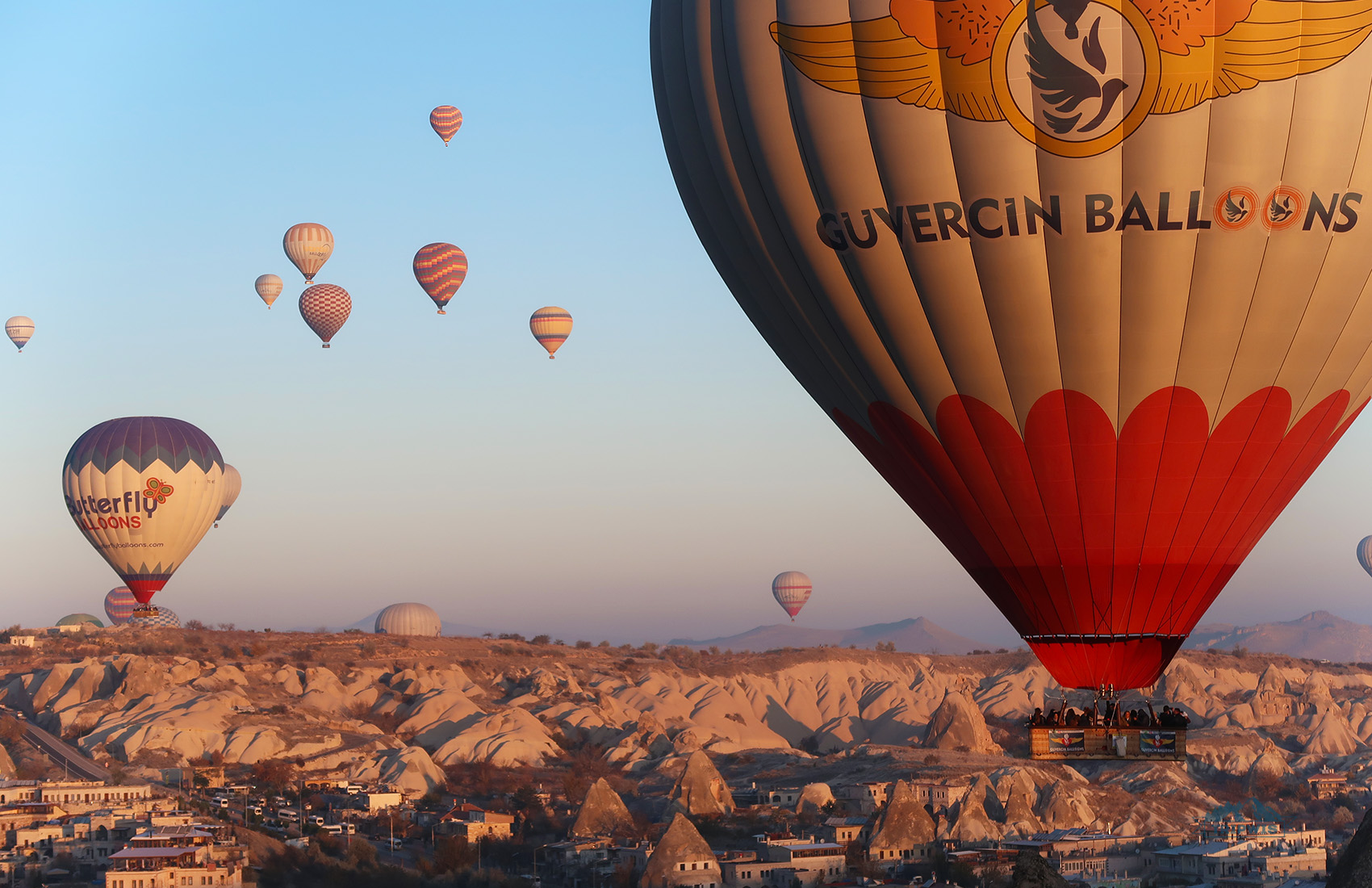
When is the best time to visit Cappadocia? The answer is simple — whenever you get the chance! Hot air balloon rides happen year-round, and every season’s quirks and downsides can be mediated with some thorough planning. Last time we came here was in November — we covered Antalya and Cappadocia in one fell swoop, which turned out to be the recipe for a fantastic holiday!
Peak season in Cappadocia falls on summer months, from June to August. I wouldn’t say it is necessarily the best time to come explore the region, since day temps can reach +30°C (86°F) and it is not pleasurable walking outside in this weather for prolonged periods of time (which is essentially all there is to do in Cappadocia).
Off season in Cappadocia lasts from November till March. Get ready for cold temps (with snow at times), whipping winds, and general lack of pleasing sights — everything turns dull and gray here in winter. There are more risks of hot air balloons delays and cancellations during this time, so leave more leeway in the number of days you spend in Cappadocia. And don’t forget to bring warm clothes (that includes pajamas, since cave hotels are notoriously damp and cold even in summer months, more so in winter).
Shoulder season — September/October and April/May — is, in my opinion, the best time to visit Cappadocia. In the words of that one girl from Miss Congeniality, this is when it’s “Not too hot, not too cold, all you need is a light jacket”.
Map of what to do in Cappadocia
Despite being a quite compact region, it still can be tricky to navigate Cappadocia’s top attractions if it’s your first time here. I know from experience that seeing a map of places we want to see in a new place makes for easier itinerary planning — so I’m doing the same for you.
I hope that my exhaustive list of things to do in Cappadocia in Turkey has not only been a fun and educational read, but also helped you organize your next Cappadocian adventure to a T! If you have any questions on the topic, feel free to leave them in the comment section down below!
